












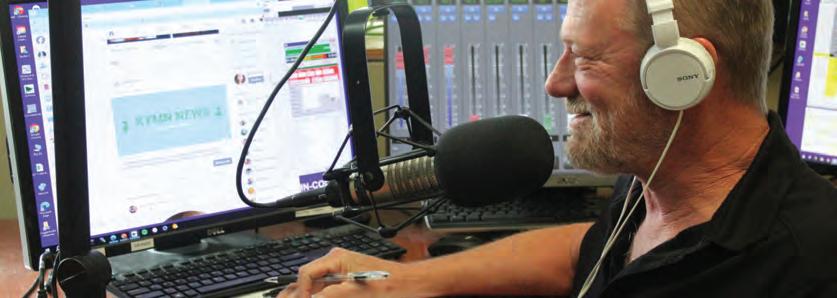
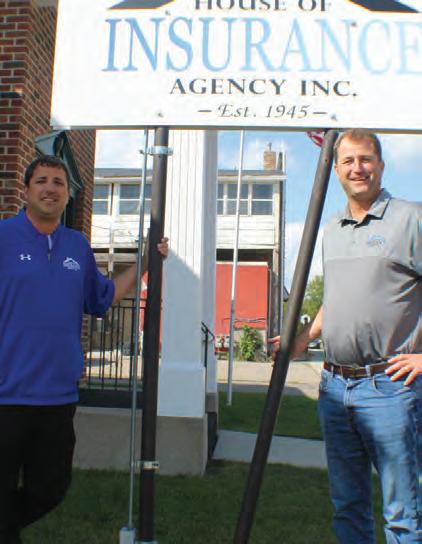


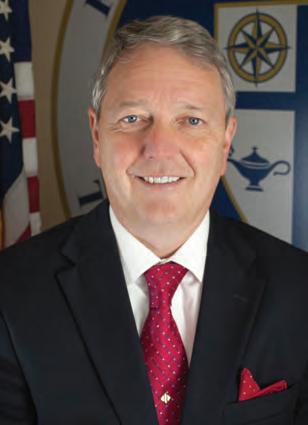

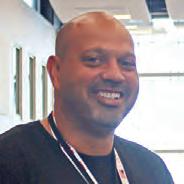


Owatonna’s Brian Coleman building a better future


St. Peter’s Zuleika Abdi helps St. Peter’s immigrant community feel welcome Le Center’s Hunt Family has kept Le Center insured for over


Waseca’s Rostislavovich mingled with world leaders atop GOP before settling here
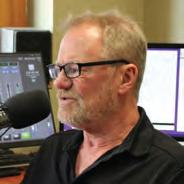
St. Peter’s Ann Volk is a ‘dynamo’ full of fun and service 6 9 16 19 25 28 37 34 4 12 22 31
Le Sueur’s Wyatt Bienfang is forged by fire, sustained by
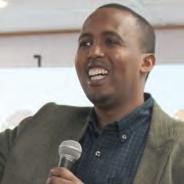
ROSS ULRICH PHILIP WEYHE
Northfield’s Jeff Johnson on radio retires voice,early mornings, long career
Owatonna’s Gail Zollner is a natural fit as Owatonna’s ‘mom’
Faribault’s Bashir Omar guides families through unfamiliar systems


Waseca’s Cochrans of Kiesler’s Campground
ADVERTISING: DEANNA BOLAND, AMBER CASTERTON, KATHLEEN DAVIES, CHRYSTAL HOBART, TIM MART, JIM PODRACKY & TONI SCHMIDT DESIGN & LAYOUT: KATE TOWNSEND-NOET
is distributed to subscribers and readers of the Owatonna People’s Press, Faribault Daily News, Northfield News, Kenyon Leader, Waseca County News, St. Peter Herald, Le Sueur County News. ©2023 This publication is copyrighted by APG Southern Minnesota and no content can be reproduced without permission.


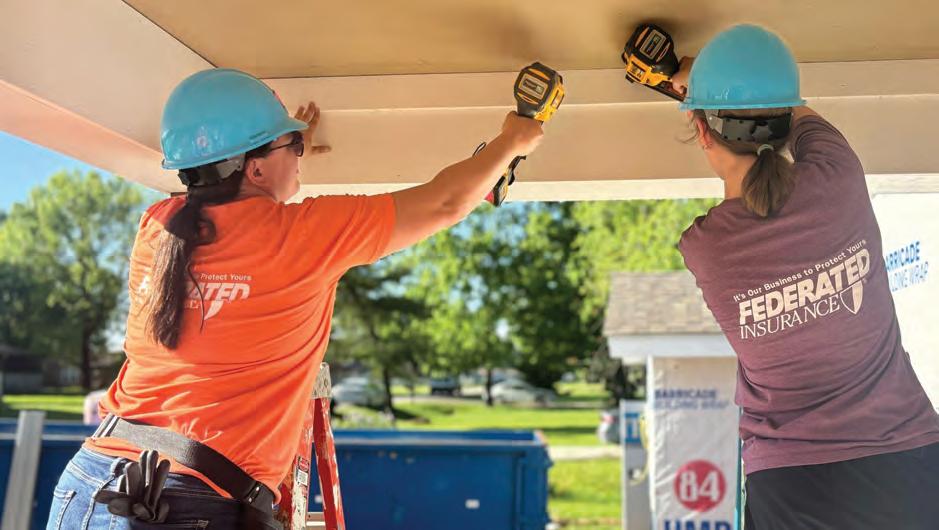




By JOSH LAFOLLETTE josh.lafollette@apgsomn.com
Whether he’s helping a student chart a course toward the career of their dreams or bringing people together for frank discussions about hard topics, Brian Coleman asks people to pursue a better future.
Known for his work as a Career Pathways navigator for Owatonna Public Schools and the key role he’s played in Alliance for Greater Equity, Coleman is a familiar face in schools, businesses and nonprofits throughout the community. In his many forms of community engagement, Coleman seeks to build a more welcoming, inclusive community one relationship at a time.
And yet, when he first came to Owatonna in the late ‘90s, Coleman felt like an outsider, singled out for his race in an overwhelmingly white community.
“I am a product of a biracial marriage. Most people don’t know that,” said Coleman. “They see me as a Black man, not understanding that I have a whole half of my family that is white.”
His early experiences in Owatonna underscore a lesson he’s been teaching for years — that one judgmental glance at a person is not enough to see the unique experiences, perspectives and skills they have to offer. While he left the community before long, he would return in time, raising his family here and growing deeply invested in Owatonna’s future.
Now entering his fourth year with Career Pathways, Coleman provides people with the kind of guidance he could’ve used when he was in their shoes. He works with teenagers at Owatonna High School and the Area Learn-
ing Center, and with adult basic education students through Community Education. Coleman has a heart for underdogs, students who may be struggling school or facing tough decisions in their future. He believes every one of them can be successful, they just need help finding the right path to pursue.
Perhaps he puts faith in them because, years ago, he was one of them.
“I was not the student that took school seriously. I actually was probably a middle-ofthe-road student. I had potential to be a great student, but I didn’t apply myself, said Coleman. “I went to school for socialization and to be with my friends. I didn’t take school work seriously, I did enough to pass.”
Coleman said he persisted with that attitude throughout his undergraduate experience, only having a change of heart when he went back to get his Master’s degree in business administration, with a minor in marketing. At the time, he had no inkling that he would become an educator. Coleman said he pursued a business degree because he believed those
skills would open many doors for him in life. He still draws upon those skills today, but in ways that he never could’ve envisioned.
According to Superintendent Jeff Elstad, Coleman’s background makes him an excellent model for students — his story demonstrates that people can succeed even when their lives and careers take unexpected turns and things don’t go according to plan.
Indeed, Coleman’s first foray into career counseling began with an unexpected turn. Years ago, he walked into a staffing agency to see if they could help him find a job. Instead of referring him to another employer, they hired him.
Since then, he’s worked with people of all ages, helping them identify their skills and interests and find a way to apply them. Looking back, Coleman can’t identify the moment he decided to be a career counselor. He simply started helping people, as is his nature, and never stopped. He credits his family with mod-

Brian Coleman helping out at Food and Brewfest in 2021. The event was originally organized by the Cultural Diversity Network of Owatonna to give people a chance to sample culinary offerings from around the world. That group, which Coleman was active in, later merged with the Better Together Committee to form the Alliance for Greater Equity, and Coleman was elected the first AGE chair. (Photo courtesy of Brian Coleman)
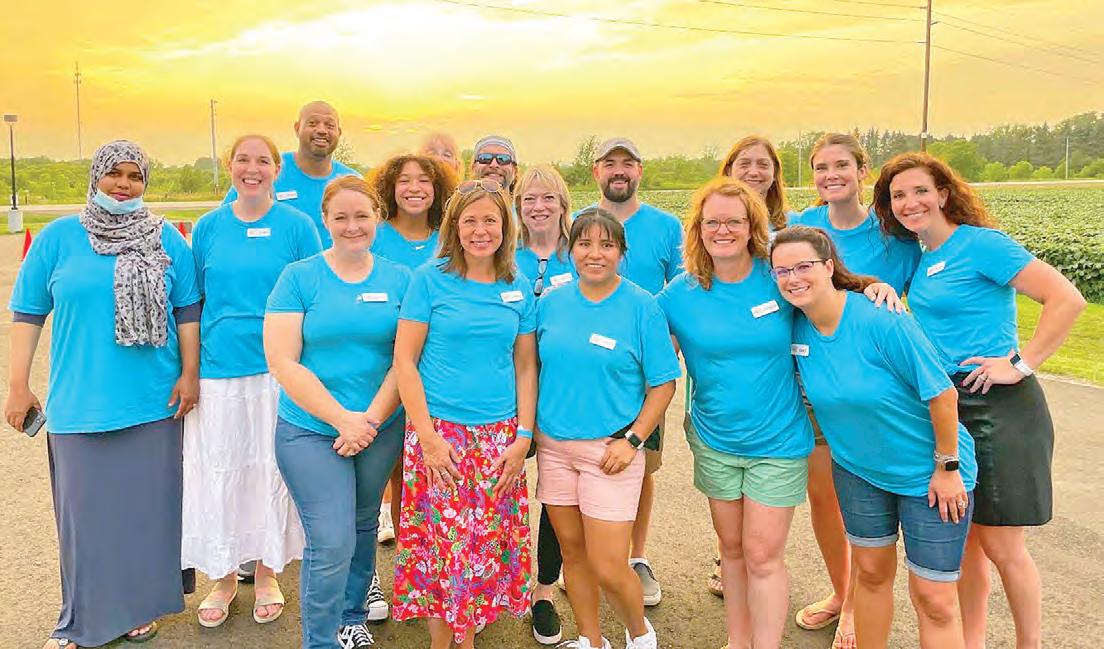
groups
CONTINUED FROM PAGE 3
eling how to be a helper. Whenever someone in the family needed help with something, everyone would pitch in. Coleman recalls helping relatives with all manner of laborious projects in his youth, digging foundations and doing whatever house work was needed.
“My mom will sacrifice and do whatever for anybody, and I see that in my brother as well. I think that’s just the way we were raised from an early age,” said Coleman.
After his first stint in Owatonna, Coleman
became a career counselor and adjunct business professor at a university in South Dakota. While workin there, he received a call from his brother informing him that their father, who had cancer, was on life support. Coleman went back to his native Michigan to say goodbye to his father and spend time with his loved ones.
Even as he was seeing to funeral arrangements and his family’s needs, he was inundated with calls from the university, concerned with who would teach his class while he was away.
Upon returning from his father’s funeral, Coleman immediately began looking for a new
about
job. His search brought him back to Owatonna in 2000, working for Workforce Development Inc. Over the next 15 years, he went from career counselor to area manager, overseeing three counties. Coleman said his work there pushed him out into the community, making him more aware of the challenges people faced locally and the work being done to improve Owatonna. Immediately, he knew he wanted to be part of that work.
In 2015, Coleman signed on as service learning coordinator for Faribault Public Schools, offering the same kind of guidance he now
gives to Owatonna students. For several years, Coleman split his time and energy between Owatonna and Faribault, an arrangement that left him feeling somewhat disconnected from the community he called home. Since joining Owatonna Public Schools in 2021, Coleman said he’s been able to focus on the one community and get more involved than before.
According to Elstad, Coleman was ‘instrumental’ in the development of Career Pathways, which has given countless students the opportunity to gain real workplace experience and become full-time employees at local businesses. Elstad credited Coleman with building strong relationships with students and the district’s partners in the business community.
The two have worked together in other capacities, including serving as board members for United Way of Steele County. In all their work together, Elstad said he’s come to know Coleman as someone that can be depended upon unconditionally, and he particularly admires how Coleman offers steady support to people of all ages and sets them up for success.
“He’s got you until you’ve got you,” said Elstad.
Coleman attributes the success of Career Pathways in large part to the support of Steele County’s business community. For evidence of his ties to local employers, one need only look at the row of branded baseball caps prominently displayed in his office at OHS — freebies displaying the logos of businesses from Kibble Equipment to Curt’s Truck and Diesel. He’s noticed that something as simple as a hat with a logo on it can pique a student’s interest in local employers, and he makes a point of asking for one whenever the opportunity arises.
He and his fellow Career Pathways navigator Missy Koch are locked in a friendly competition to see who can collect the most hats from local employers and, according to Coleman, he’s currently in the lead.
“I’m running out of space. She’s not,” said Coleman, with a hint of satisfaction.

Of course, the real proof of his place in the business community is the relationships he’s built with employers. Brad Meier, president and CEO of the Owatonna Area Chamber of Commerce and Tourism, said Coleman is always constantly active in the community, engaging with local businesses.
“He’s got a magnetic personality. He’s someone that likes to be around people and talk to people,” said Meier.
Meier said Coleman’s genuine interest in others is what makes him such an appealing person to be around. He also highlighted Coleman’s critical role in the Youth Skills Program in Owatonna, a state-backed initiative that allows students to explore specialized on-the-job training before graduation. Meier said Coleman is effective at connecting students to employers because he’s earned their trust, and that he’s benefitted the entire community by helping students find jobs and helping employers find the workforce they need.
According to Coleman, working with high schoolers isn’t all that different from working with people in the broader community. As much as adults may like to think they’ve put the cliquishness of adolescent behind them, he sees the same dynamics at play in all ages.
“ There’s so many silos within this community of different people and different groups,” said Coleman. “It reminds you of high school. Here’s your musicians, here’s your jocks, here’s your cheerleaders.”
Through his work at AGE, Coleman urges people not to be bystanders, but “upstanders” — individuals who connect with others, and take action when they see something wrong in the community. According to AGE Chair Rebecca Moore, Coleman is one of those upstanders, and it’s that very quality that has made him an indispensable asset to the organization from the beginning.
“We were looking for people who wouldn’t be afraid to speak out on challenging issues, and I knew Brian would be willing to do that,” she said.
Moore and Coleman have both been actively engaged in efforts to promote racial and cultural inclusion in Owatonna for years, with Moore serving on the Better Together Committee and Coleman on the Cultural Diversity Network. In the wake of the murder of George Floyd bringing heightened awareness to the problem of racism in America, members of the two groups came to believe they could be more effective as a single organization. When they officially united at AGE, Coleman was elected as chair. Moore said Coleman was an obvious choice for the role, calling him a community servant and a strong leader.
In presiding over board meetings, Moore
said Coleman sought diverse input, never afraid to ask, “whose voice isn’t in the room?”
She also highlighted his welcoming personality, the key trait that helps him bring people together.
“He can be a friend to anybody,” she said. Moore said Coleman inspires others to do good and be authentic, and his ability to listen to others builds trust and makes him easy to open up to. In addition to all the work they’ve done alongside one another, she also appreciates the work he’s done in the school district. Moore said Coleman gives marginalized students the opportunity to be themselves and feel safe, and that her daughter Janessa, who
graduated from OHS in 2022, was grateful for his guidance and support in high school.
“It meant a lot to her that he was in her corner,” said Moore.
Since his term as chair ended in May, Coleman has handed the reins off to Moore, the current chair, and Vice Chair Muna Mohamed, but he remains an active board member of the organization.
Coleman sees his work in the schools and in the broader community as inextricably linked. Working with students in Career Pathways has given him access to a wide variety of youth perspectives, which has informed his work at AGE. In fact, helping young people find their place in the community may be a step toward building a more welcoming and just society.
“I think our younger generation, truthfully, they understand. They get it. But they don’t have a platform. They don’t have that voice. They’re probably being told to be quiet,” said Coleman. “They are so bright, and our future is so bright because of them.”
Since he first moved to Owatonna, he’s seen more and more people willing to ask questions, have tough conversations and accept change. In the end, that’s all he asks of anyone. Coleman acknowledges that no two people are going to agree on everything, but he believes the barriers that divide the community can come down if people are willing to sit down with each other and simply listen.
Coleman’s first stint in Owatonna actually provides a model for how this can be achieved. Feeling isolated, Coleman made connections at the West Hills Community Center, which was still in operation at the time. While he was just looking for a place to lift weights, play basketball and socialize, he ended up making a number of lasting friendships.
While the community center is long defunct, Coleman has spent his years in Owatonna making similar spaces where people of different races, cultures and faiths can feel welcome. He acknowledges that the work is nowhere near over, but when he considers the strides the community has already made, Coleman looks to the future with a sense of hope.

(File photo/southernminn.com)

By LUCAS DITTMER lucas.dittmer@apgsomn.com
Shattuck-St. Mary’s has a long, storied history in Faribault, which includes their hockey program that was started in 1927. With the program being nearly 100 years old, one man has been serving at the school and working with their hockey program for more than half of that time.
Steve “Rooster” Erickson is the sports complex assistant manager at the Shattuck-St. Mary’s. He started working at the school officially in 1992, but his ties in being active with the school go back to 1974.. Rooster has made incredible memories throughout the years, and he has memorabilia that proves it.
The Shattuck-St. Mary’s hockey program, which is titled the Hockey Center of Excellence, started in 1927. Hockey is one of four of the school’s centers of excellence among sports, along with soccer, figure skating, and golf.
Since the school is a private boarding high school, many teenagers from around the country and around the world enroll in the school and showcase their talents in their respective sports and their knowledge in the classroom.
Shattuck-St. Mary’s is known for their alumni in their hockey program history, with many of them going on to play in the NHL and the Olympics, including Sydney Crosby, Zach Parise, and Jonathan Toews.
While the hockey players at the school are all high school students, their competition is not against fellow high schools, but rather USA Hockey AAA teams around the country. The USA Hockey organization won’t let Shattuck-St. Mary’s play high school teams and the Minnesota Hockey organization won’t let their high school teams play them.
The school has 8 hockey teams: 5 boys teams and 3 girls teams. After adding a third girls team two years ago, the school is in talks of adding a fourth girls team in the future. The boys teams consist of a U14, 15O, U16, U18, and prep, while the girls have a U16, U18, and a prep team. The school has open tryouts for the team so a student at the school can try out for any of the teams and make it based on their
performance in the tryouts.
With the school having many of the top future NHL and Olympic hockey athletes going to school, Shattuck-St. Mary’s Hockey Center of Excellence has 36 national championships in their history. Erickson has been there for everyone.
“I hung every one of those banners,” Erickson said.
Erickson was born and raised in Faribault, and graduated from Faribault High School in 1974.
“I grew up here in town,” said Erickson. “I have brothers and sisters here and my mom and dad were good workers here in town. The Erickson’s have kind of carried on that work ethic and all of us are still working and doing our thing.”
Erickson has played hockey throughout all his life, starting when he was a kid in Faribault when there were only a few kids in the town doing so. That’s how his life at Shattuck-St. Mary’s came to a start in 1968.
“Back in ‘68, there was only a little group
of us Faribault kids who played hockey, so we all came up here to play hockey and we got to know the Shattuck people,” Erickson said.
One of the Shattuck people Erickson got to know was John Sumner, who was at the school for over 40 years as a hockey, football and baseball coach, physical education teacher, and athletic director. One of the school’s three ice rinks is named after him.
The ice rink at the school was the only indoor hockey rink in southern Minnesota for a long time, so it was a hotspot when Erickson was in high school in the 1970s.
His first experience at Shattuck-St. Mary’s was in 1968 skating on the ice.
“I skated in that rink in ‘68 when it was built while I was a 10-year-old kid,” said Erickson about the ice rink at Shattuck-St. Mary’s. “That’s the only home ice rink I’ve ever known.”
After playing hockey in high school, Erickson continued to play hockey into his adult life with the Curve Bar Golden Bears.
“I just always played in the men’s league here in Faribault up until 15 years ago when I had open heart surgery, so that kind of slowed me down a little bit,” Erickson said.
Erickson was a goaltender during his playing days and while he has skated a couple of times since, he hasn’t put on the pads at all. But that didn’t stop him from continuing his work in the hockey business. Working at the sports facilities and complex at the school keeps him active with his passion for hockey.
Even though the school credits Erickson as being an employee starting in 1992, he has been working at the school off and on since 1974, which was when his first experience driving the Zamboni for the school.
“I drove the Zamboni here in the old rink for the first time in 1974, so I’ve been actively involved in something here since 1974,” said Erickson.
Erickson officially started working at the school in 1992 as a part-time employee. He worked part-time until 2006 when the school added a new ice rink and needed another person to work nights. Erickson was offered the job and became a full-time employee at the school.
While he was working part-time helping with the sports complex and facilities at the school, Erickson was working full-time at Crown Cork & Seal in Faribault in the shipping department. He worked there for 30 years before he left to be a full-time worker at ShattuckSt. Mary’s.
“I left my job after 30 years and came here not knowing what to expect really other than I’ve done it all my life,” said Erickson about the change in 2006.
Erickson is now the assistant manager at the school’s sports complex titled Putrah Sports Complex and is also the equipment manager for all of the hockey teams at the school. His main responsibilities at the school are

taking care of the facilities, resurfacing the ice, making sure the schedule for the facilities is correct, and taking care of the equipment, which includes sharpening skates and fixing all the gear.

“We
town, so for some of our kids I’m the pro shop,” Erickson said. Erickson also takes care of the brand new multi-used turf field and the famous dome at
the winter time and Erickson helps maintain that as well along with his various duties con-




cerning the ice rinks and the hockey equipment.
Sharpening skates is one of the tasks Erickson works on every day. Because there are 160 hockey players at the school, there are 160 skates that have to be sharpened throughout the week.
What Erickson is probably most known for is him driving the Zamboni, as he said he probably has more time behind the wheel than anybody in the school’s history.
“Every time I hop on it, I treat it like it’s my first day driving it,” Erickson said. “That’s the old farm boy in me, that was instilled in me by my Grandpa back in the day. He always said that you must take care of your equipment because your equipment will take care of you.”
While he didn’t go to Shattuck-St. Mary’s when he was younger, the school made Erickson an honorary alumni due to his many years of service at the school.
“I suppose if you put all this time here, they got to make you something,” Erickson said about him being an honorary alum.
Along with driving Zamboni, Erickson is also known for his office, which he calls his “shack” and has been called his “coup” as well. The shack is full of hockey memorabilia throughout the years, with the collection starting when he was a teenager collecting jerseys.
“I’ve been collecting some of that stuff since the ‘70s when I was in high school,” Erickson said about his memorabilia in his shack. Erickson also has about 150 jerseys at home hanging in his basement.
The items in his office at Shattuck-St. Mary’s are mostly all items from other people given to him.
“I always tell everybody I probably have bought ten things in here,” Erickson said about his shack. “Every time I turn around, somebody’s giving me something, somebody’s always handing me something. And ironically they come back ten years later and ask ‘hey do you still have that pair of gloves I gave you?’”
A lot of Shattuck-St. Mary’s players leave

their stuff at the school so they can be stored in Erickson’s shack. The same thing happens with hockey players that are passing through as well.
Many historic hockey players have sent their kids to school at Shattuck-St. Mary’s, including Wayne Gretsky. People in the entertainment industry outside of hockey have passed through as well.
“I’ve gotten to meet a bunch of Hollywoodtype people too that come through here, including musicians,” Erickson said.
Erickson has got to befriend many hockey legends through his work at the school as well, including one of his idols and mentors J.P. Parise. Parise was a hockey player who
played for the Minnesota North Stars and was the hockey director and coach at Shattuck-St. Mary’s.
“As a kid growing up here in Minnesota, to see J.P. as a North Star, you love him as a player and then get to work with him and he calls you a friend, I would have never in a million years thought that would ever happen,” Erickson said.
Erickson also noted that J.P.’s connections with the North Stars saw his teammates occasionally hang around the school as well. With former hockey players sending their kids to the school as well, the school has hockey legends on campus all the time.
“You had all those guys here all the time, so

it’s like hockey heaven,” said Erickson. The school also hosts a camp in the summer time for students ages 10-15 years-old.
“ The cool thing about our camps is that some of the parents are Shattuck alums, kids that I was familiar with and were kids here at school themselves are now back here at camp with their kids, so I’m like Grandpa Rooster all of a sudden,” Erickson said.
A lot of the time, the players and former alumni give items and memorabilia to Erickson so they can have it hung on the walls in the shack. Because of this, the shack is a minimuseum of all the hockey figures that have made an impact on Shattuck-St. Mary’s and the Faribault community.
Erickson’s life revolves around hockey because of his love for the sport and his job, but he keeps busy with other areas of his life as well, which includes him being in a band and being a husband, father, and a grandfather to 6 grandchildren.
Since he is turning 70 in two years, Erickson is questioning when his time at the school will come to an end. Erickson noted that he has worked 55 days in a row at the school because of the summer camp.
“It’s great coming here every day,” Erickson said. “I’m in the hockey world, but I’m almost to the point where I’m hockeyed out.”
Through his life in hockey, Erickson has touched the lives of so many students and players, giving them advice about their education and hockey careers.
“I tell everybody it’s hockey and sports here, but it is still school,” said Erickson on his advice to students. “You still have to go to school. You still have to take your classes and pass your tests and all that. And your hockey sticks that you have will prop open a lot of doors for you, but it’s your education and your personality that is going to get you in that door and get you hired somewhere.”
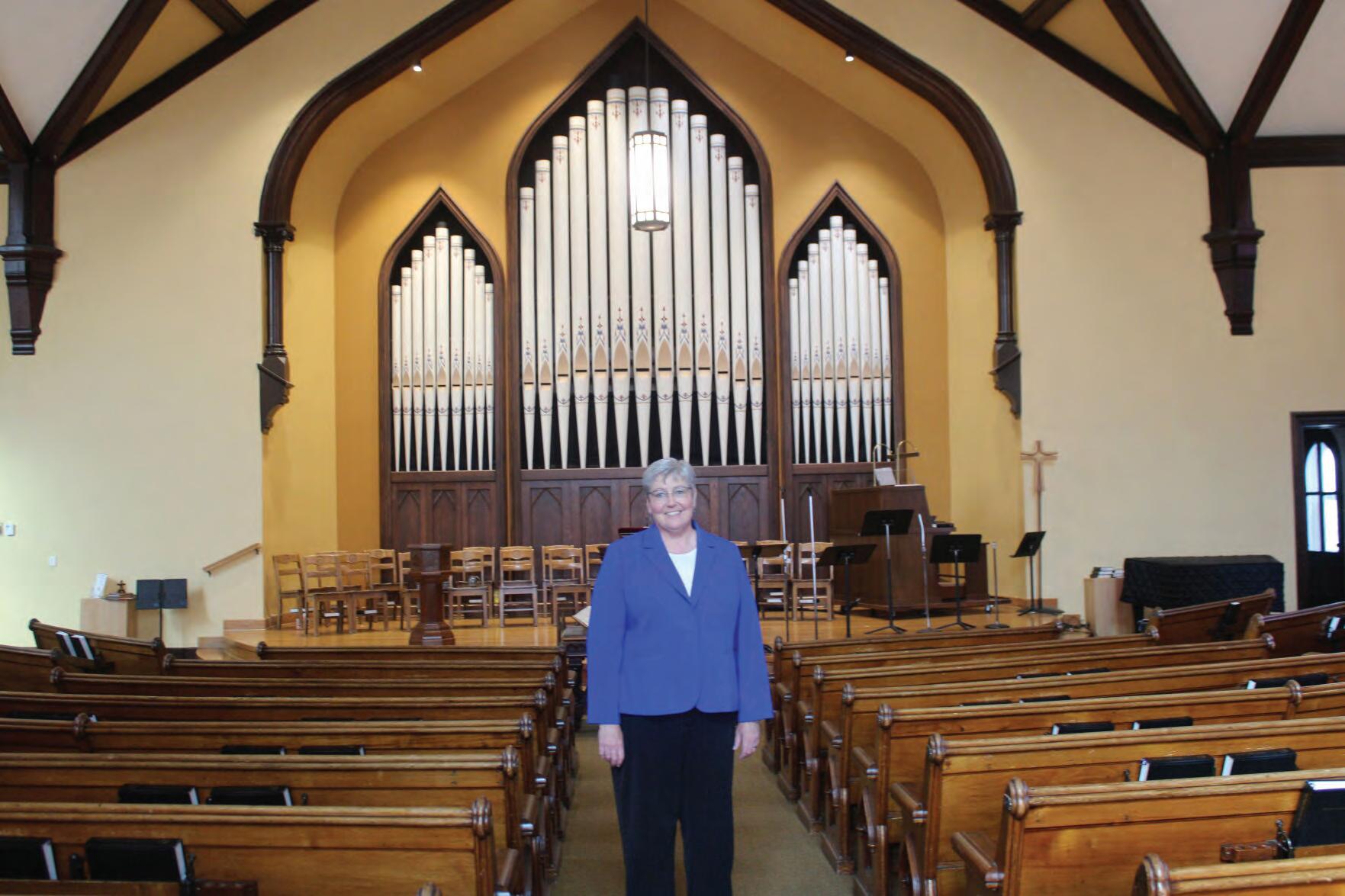
By PAMELA THOMPSON pamela.thompson@apgsomn.com
Asign outside of the UCC Northfield church that reads “We apologize for hateful things done in the name of God” may be Rev. Cindy Maddox’s personal battle cry.
Maddox, a 60-year old married lesbian, took over the helm at First UCC three years ago. In May, she suffered a near fatal cardiac arrest that denied her brain oxygen for several minutes and sent her to the ICU for 10 days.
“I was heating up a Costco frozen dinner when I suddenly collapsed in the kitchen,” she said. “I literally would not be here if my wife Jackie hadn’t immediately administered CPR.”
The three month road to recovery had many challenges. Despite an outpouring of support from her church community, friends and
neighbors that included cards, notes, flowers, meals and lawn mowing services, Maddox said retraining her brain to play the piano, do jigsaw puzzles and remember names has been a slow process.
“At first, I didn’t know a flat from a sharp,” she said citing her piano skills. But gradually, with the help of a home nurse, occupational therapy and her wife’s love and support, she has made steady progress.
Maddox said an underlying health condition may have caused the two chambers of her heart to stop communicating. “I learned the hard way that a cardiac arrest is electrical and a heart attack is about plumbing.”
Maddox said she gives high praise to the staff at Northfield Hospital, the EMTs and “this fabulous small town with great resources.”
Now, with a pacemaker to keep her heart in check, Maddox hopes to use her shocking medical emergency as another way to help and relate to the needs and concerns of her congregation.
“
I believe in the ministry of presence. I can’t fix cancer, but I can walk beside you on your journey. This is what I signed up to do, to share people’s pain. That’s the job.
- Rev. Cindy Maddox
“I believe in the ministry of presence,” she said. “I can’t fix cancer, but I can walk beside you on your journey. This is what I signed up to do, to share people’s pain. That’s the job.”
As a trained listener who admits she is not comfortable asking others for help, Maddox said that being on the receiving end is harder for her than being on the giving end. That independent attitude certainly caused a bit of strife with her wife Jackie McNeil when the
doctors tried to tell her that Maddox was not responding to the foot taps they were administering.
“Jackie told the doctors that in the 16 years she’s known me I was never one to follow commands,” said Maddox with a laugh. Although she remembers very little from her stay in the hospital, Maddox said she is reminded of her long recovery every time she mentions want-
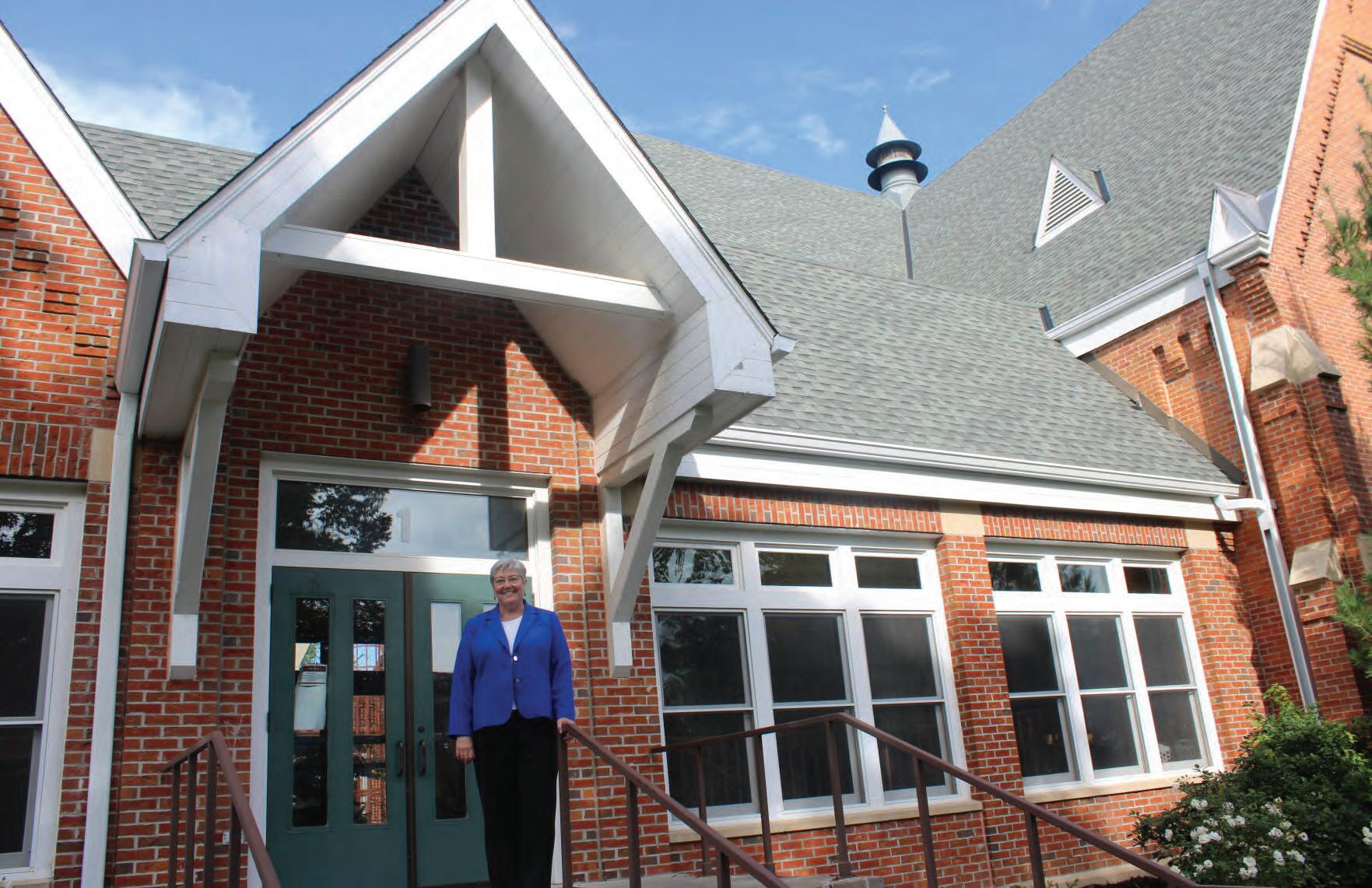

- Rev. Cindy Maddox “
I’ve seen the way acceptance changes lives.”
28, Maddox returned to the pulpit a delivered a sermon titled “This Day,” a nod to giving thanks for the gift of one more day of this precious life. Maddox said she feels most alive when she’s bringing the scripture alive.
“I love looking out at the congregation and seeing them so engaged,” she said.
When Rev. Cindy Maddox was looking for her next open, welcoming and affirming church home, she said she was intrigued that First UCC Northfield wanted a clergy leader who would spend one-fifth of the time in service to the community and wider world.
“I was immediately drawn to the church’s long and strong history of social justice,” she said. “That appealed to me so strongly.”
Now, after three years as the head clergy of the Union Street church, Maddox is also serving as chair of the Northfield Pride in Park committee.
Maddox said she’s glad to have the opportunity to ensure that Northfield continues to provide more support and more services to the

three years ago. (Pamela Thompson/southern-

LGBTQ+ community.
“I’ve seen the way acceptance changes lives,” she said.
Raised in a conservative, evangelical church, with a traditional father as the minister, Maddox said her family made frequent moves from church to church around the midwest and the south. Her call to ministry drew her to study at Emory University’s Candler School of Theology in Atlanta.
“I love preaching,” she said. “My dad was a good preacher. He was a big man at 6 ft. 3
inches and he would literally leap out of his chair to get to the pulpit.”
In the mid-1990s Maddox came out as a Lesbian. She called that period of her life difficult but in a different sense. “It was difficult to believe that it was true,” she said. “To really make it be true I had to embrace it and know it in my heart. That took time.”
When she was ordained in North Carolina, Maddox said she was the first openly LGBTQ member to be ordained in the UCC church in that state. That notoriety as a social justice

and equality ceiling breaker thrust her into the spotlight of the ongoing controversy.
“I was suddenly in the news all across the state,” she said. “I felt vulnerable and intimidated.” Having the full support of her congregation got her through that painful period. She remembers finding additional strength from a fellow clergy member who advised her to “stay the course” despite the heat.
She also received many hate filled anonymous phone calls.
As a clergy member, Maddox has worked
in nine states and has discovered that different types of social values and acceptance exists in different parts of the country. She said she thinks the lyrics of the Indigo Girls song “We Get to Feel It All” hint at the good and the bad, the brokeness, the joys, the woundedness and the celebrations of life in America in the 21st century.
“I get to feel it all here in Northfield,” she said. n
Pamela Thompson is the associate editor for the Northfield News. Reach her at 507-645-1115 or pamela.thompson@ apgsomn.com.









outside the Arts Center of
where she hosted
Night for
has been a consistent advocate for the area’s Somali community, using her skills as a community organizer and interpreter to foster cross-cultural friendships, educate the youth and help her neighbors navigate needed services. (Carson Hughes/southernminn.com)
By CARSON HUGHES carson.hughes@apgsomn.com
When Zuleika Abdi and her family made the journey from her homeland of Somalia to Nashville, Tennessee in October, 2016, she was in for a challenging transition.
After spending the past 20 years in a Ugandan refugee camp, Abdi found herself navigating a large city of 680,000 people with no car, an intermediate grasp of the English language — all while working as a housekeeper to provide for her family as a single mother of five.
It took a long time for Abdi to adjust to her new surroundings. She had no family nearby, the county was lacking in resources for
Somali-speakers and without a driver’s license she needed to rely on public transportation to take her to her workplace at the St. Thomas hospital. the grocery store, her kids school and everywhere in-between. Though Abdi was quick to make friends and find supportive people in her community, she felt stuck as the daily challenges of life in Nashville held her back from achieving her own goals.
But everything changed for Abdi when she took a leap in 2021 and moved 800 miles north to the small town of St. Peter. In the three years since resettling in the area based on a relative’s recommendation, Abdi has grown into a voice for her community — using her talents for fostering personal connections and her fluency in English and Somali to bridge the gaps between St. Peter’s immigrant community and the wider populace.
Whether it’s coordinating events like the Festival of Nations as a member of the St. Peter Good Neighbor Diversity Council, helping local Somali youth learn and grow as a volunteer
with WellShare and the St. Peter Islamic Center’s after-school Hikmah program or helping bring VINE’s services for aging adults to the area Somali community, Abdi works around the clock to ensure that those who feel the same struggles she once did can find a sense of belonging in the St. Peter-Mankato area.
“I always wanted to be helpful to people, so that people can feel that,” said Abdi. “And if you took a microphone today and went to the community and asked, 95% of them will tell you, ‘Oh yes, Zuleika, she is what she says she is.’ And St. Peter enabled me to be that person, especially when I joined the Good Neighbor Diversity Council.”
It was through the Good Neighbor Diversity Council, co-founded by Bill Nelsen and Mohamed Abdulkadir in 2022 as a means of building cross-cultural relationships in the St. Peter community, that Abdi took her first steps towards serving as an advocate for Somali immigrants.
Abdi joined the group spontaneously after
hearing the Good Neighbor Diversity Council would be marching in the 2022 Old Fashioned Fourth of July parade. She didn’t know much about the group, but when a community leader told her about the event, she asked how she could become a member.
Before long, Abdi was playing a leading role in coordinating the Diversity Council’s largest annual celebration, The Festival of Nations. Alongside fellow volunteers Echocce Mendoza and Trish-Hiscock Austin, Abdi was in charge of recruiting a multicultural array of musicians, dancers, artists, craftsmen and cooks for a global celebration of the many cultures that make up the St. Peter community.
Boasting over 1,000 attendees in its second year last May, the Festival of Nations has quickly become a landmark event for St. Peter. Putting a spotlight on everything from Somali folk dance to Latin music, Eastern European folklore, Indigenous artwork and Middle Eastern cuisine, the festival with its emphasis on cultural exchange and free food and entertain-
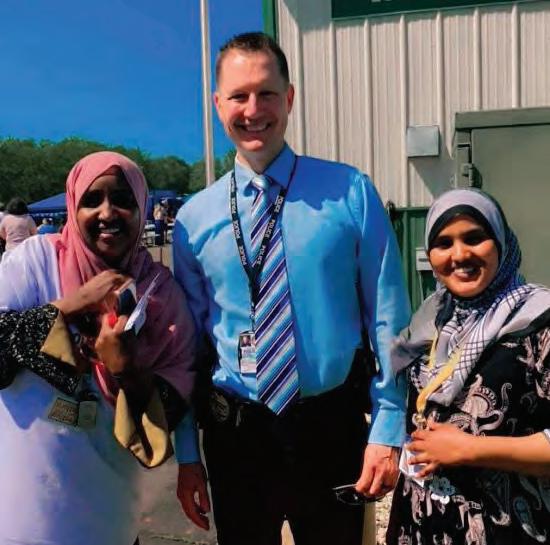
Zuleika Abdi (left) is pictured with St. Peter Police Chief Matt Grochow and her friend Hani at the St. Peter Festival of Nations. Abdi was a key organizer of the event which brings together over 1,000 people to celebate the diverse cultures that make up St. Peter. (Carson Hughes/southernminn.com)
ment, has made it a popular destination for St. Peter residents of all stripes.
Abdi has also spearheaded the Good Neighbor Diversity Council’s Ladies Night, a private event at the Arts Center of Saint Peter where women could come together and have fun with no restrictions, and the Islamic Center’s Eid al-Adha feast celebrating the end of Ramadan.


Just as the group’s title suggests, Abdi said the council’s work is helping people become good neighbors to one another. Not only does she recognize more people on the street in her day-to-day life, she sees more people getting involved in the community too.
“ There were even some Somalis that were not coming out of their house/ They were

always kind of isolated but they came out and I know them because of the Good Neighbor Diversity Council. So it made me meet different, nice people,” said Abdi.
The connections Abdi made through the Good Neighbor Diversity Council served as a stepping stone for her to become more active in the community. Today, Abdi works as a
contractor with WellShare International’s Youth Leadership programming helping immigrant youth in the St. Peter area practice healthy living. Each weekend, Abdi coordinates health classes for groups of 30 students at the Islamic Center where they learn about disease preven-



CONTINUED FROM PAGE 13
tion, vaccination, healthy eating and engaging in an active lifestyle.
As part of her participation in the program, Abdi received a community health worker license which she now utilizes at WellShare and in her role as a Somali community outreach worker for VINE. As a bilingual Somali-English speaker, Abdi uses her skills to help Somali elders benefit VINE’s transportation and home
visit services and the non-profit’s Meals on Wheels program.
Abdi can also be found assisting with the Islamic Center’s after-school Hikmah program. Offering both classes for helping students on writing, reading and math alongside recreational opportunities, the program is oriented around improving the academic performance and social bonds of St. Peter’s East African students. As a parent with six kids enrolled in the
to St. Peter or new to America, so she’s able to bring all of her experience and her skills with relationship-building, her language skills of being able to speak Somali with folks in our community,” Hiscock-Austin continued. “She’s just an amazing asset to St. Peter.”
While collaborating with Abdi in the Hikmah program and in her own youth program providing kids with opportunities to connect with nature, Grass and Roots Outdoors, Hiscock-Austin said Abdi not only has a talent for connecting with kids and getting them excited, but also relating to parents who want to ensure their children are safe and supported.
When a kid is uncomfortable going on an excursion to a place they’ve never been, such as a forested area with winding muddy trails and buzzing insects, Hiscock-Austin said Abdi is quick to jump in and assure them she will be there to keep them safe. She does the same with cautious adults as well.
Hiscock-Austin recalled a recent experience where they took kids out canoeing on Duck Lake and Abdi rounded up 15 mothers who had never been out on the lake before to try canoeing with their children.
“You feel like you can do anything if Zuleika is there encouraging you. Everything is going to be OK, as long as Zuleika is looking out for me and wants me to make a memory and feel more confident,” said Hiscock-Austin.
Even when she isn’t formally volunteering, Abdi regularly helps out her less fluent neighbors by serving as an interpreter to help them access necessary services.
“If they need help applying for anything in the county or something that they need, if it’s schools, if it’s the hospitals, I help them directly with the right resources,” said Abdi.
For all of her adult life, Abdi has been using her knowledge of the English language to help others in her community navigate language barriers. She was just seven years old when she fled the civil war in Somalia in 1993 with her father and five siblings and became one of the first refugees placed in a camp in Uganda where she would spend the next 23 years of her life. She spent some time learning English in school, but Abdi said what deepened her knowledge of the language was her eagerness to befriend English-speaking UNHCR staffers in the offices.
The refugee families, who are still fleeing to the camp as the civil war in Somalia rages on, were provided food and tents for shelter. As she grew up in the camp, Abdi took on the role of a community resource helping aid new asylum seekers become accustomed to life in the camp. She also served as a volunteer interpreter for UNHCR, where she helped fellow refugees make their cases for asylum.
From that experience and her volunteer work in the St. Peter community, Abdi has come to view her ability to form friendships and connections with others as one of the primary ways she can give back.
“I think there’s a lot of people who want that positive living and nice way of doing things,” said Abdi. “I do not have a lot of knowledge, I am not a professor, but just the little I am I feel like that is what humanity needs in my perspective. I don’t have a Ph.D. I don’t have good English, but still I try to be me.”
program, Abdi often volunteers as a chaperone and invites new families to join the program.
“She is like the ultimate community organizer,” said Hiscock-Austin, a friend of Abdi who has worked with her on the Diversity Council and as a volunteer instructor for Hikmah. “How do you connect with people? Get a hold of Zuleika and she will help organize everybody and convince them that it’s worth getting together.”
“She’s able to organize folks who may be new
Abdi works to impart the same lessons onto her children, encouraging them to make friends with everyone they meet.
“I think if you have a group of 10 kids, you (can figure out whose is) Zuleika’s, because of how they try to behave with other people,” said Abdi. “They make friends with everyone in St. Peter, and they feel St. Peter is a safe space for them.” n








By CARSON HUGHES carson.hughes@apgsomn.com
Whether it’s a car that ran into a ditch, a farmhouse engulfed in flames or a business that’s experienced theft, the Hunt family has been helping people in the Le Center community and beyond prepare for the unexpected for more than 35 years.
Founded in 1945 under the direction of Miles Bowler, the House of Insurance Agency in Le Center has been owned and operated by the Hunt family since 1989. After taking over for their parents Tom and Marlene Hunt, brothers Darian and Randy Hunt have kept the insurance agency alive working side-by-side as business partners and family.
Since Darian, the elder brother by six years,
joined the agency in 2003, followed by Randy in 2005, House of Insurance has continued to grow, establishing a second location in Montgomery in 2008 and a third location in Lonsdale in 2021.
The Hunts are often asked how they make it work going into business together as a family. Not only are the brothers working together out of the same office at 22 S. Lexington Avenue, but Darian’s wife Hayley serves as the Le Center office’s business administrator and Randy’s wife Stacy manages the Montgomery location.
While the brothers admit to having their share of disagreements, those discussions aren’t escalating into feuds around the family dinner table. In fact, it’s rare for them to talk business at all after hours. Instead, the two have found that their shared drive to further the agency’s success, allows them to work in synchronicity.
“It works great for us and the reason it works is because we both have the same work ethic,” said Randy. “If you were with a sibling that had a different work ethic, it would be
a little bit tougher. But it’s been great, I work with my wife, my brother, my sister-in-law.”
In many ways, those family bonds have made collaboration even easier since the Hunts are aware of each other’s schedules.
With Randy and Stacy having three children in after-school sports and Darian and Hayley having an athletic eighth-grader, they’re aware of who needs to cover for who.
“ There’s definitely differences between how Darian and I might see the future or the present of things, but that’s a good thing though. You try to come up with the best of both worlds,” said Randy.
“And if it doesn’t work then the wives make the final decision,” he added with a laugh.
The Hunts also collaborate well when it comes to using the business to give back to their community. The importance of helping the community was a lesson instilled in them and their siblings Ryan and Kristin from an early age by their parents.
Before his death in 2004, their father Tom had been a dedicated volunteer in the Le
Center community. The Vietnam War Navy veteran had been a leader in the local veterans community, serving as a commander for both VFW Post 1803 and American Legion Post 108. He was also a co-chair of the Le Center United Fund and the St. Patrick’s Day Celebration in Le Center, serving as the event’s emcee, a 20-year member of the Le Center Fire Department and a past director of the First National Bank in Le Center.
Their mother Marlene shared a similar passion for community service, volunteering as a hospice grief counselor while managing the House of Insurance Agency into her retirement in 2013 and using the spare time created in her schedule to launch a widow support group.
The brothers have maintained that same community-oriented attitude with the business, regularly volunteering with their employees to load trucks for the Le Center Food Shelf, sponsoring a litany of community events and non-profits. Darian and Randy have also spent nearly 10 years responding to emergencies
while on the Le Center Volunteer Ambulance. Randy has since retired from the ambulance, but Darian continues to ride with the ambulance to this day.
“We grew up with our parents volunteering in the community, so we have definitely done the same with that,” said Darian.
Though the brothers would end up taking over the business for their parents, Darian and Randy said Tom and Marlene discouraged them from getting involved in the House of Insurance Agency right away. To ensure that taking on the family business was something they really wanted to do, their parents told them they would have to explore careers elsewhere before coming home to work as agents.
After Darian graduated from Bemidji State University and Randy from Minnesota State University, Mankato, the brothers both ended up in the insurance industry working for AutoOwners Insurance alongside Hayley and Stacy. They both moved back home as they were ready to settle down and raise a family, hoping to give their kids the same small-town childhood experience that they were raised with.
“We wanted smaller schools, stuff for our kids and we wanted to be able to have more flexibility with our kids,” said Darian. “We try to give that to our employees too, like making sure that they’re involved with the school system while their kids go to school and their after-school activities. We try to treat our employees the same way we came back.”
Darian returned to the agency months before their father fell sick, while Randy began working there full time a year after Tom’s death. It was a tumultuous time for House of Insurance, since the business was synonymous with Tom’s name.
Tom had been working as an agent for the insurance agency, then-called Bowler Insurance on Aug. 1, 1975 and purchased half of the business from Al Battig a year later. He later became the full owner in 1989.
When Tom passed away, the family privately worried that House of Insurance might lose the trust of its customers, but Marlene, who had been operating the business with her husband for over a decade at that point, was quick to step up and retain the agency’s loyal clients.
“ Things could have went sideways here 20 years ago but they didn’t and it’s because of [the customers] and my mother,” said Randy. “Dad was the face of the agency and now he’s gone? So what happens? Mom had a lot to do with it by sticking in there and hanging on and the loyalty to our local customers.”
While House of Insurance is a small town agency, its reach extends far and wide with clients ranging from people living right in Le Center to customers six hours away and beyond. Their clientele includes people buying

their first car and are renting an apartment to those who own large manufacturing firms outside the area.
The brothers say they can maintain a wide range of clients across multiple states because of their ability to build their relationships with their customers.
“It’s just simply answering the phone,” Darian said with a laugh. “It’s that simple, just to not have somebody else answer it.”
“I always tell our agents it doesn’t take much to go out and get a license and sell an insurance policy. That’s the easy part basically,” he continued. “It’s establishing a client base and building those relationships over time where you are really going to see the benefits and provide value to those clients.”
Maintaining those relationships has become increasingly important as insurance agencies have been hit in recent years by claims for hail damage as a rising number of hailstorms have swept the US. According to Swiss Re Ag, a series of thunderstorms in the first half of 2023 had racked up $34 billion in losses for insurance companies.
“ The Midwest used to be the profit grounds for a lot of insurance companies, so insurance companies would write a lot of property along the East Coast and Florida, well they needed to diversify so they would go to the Midwest,” said Darian, “Well now they’re getting pounded
CONTINUED ON PAGE 18







CONTINUED FROM PAGE 17
in the Midwest, so the reinsurance markets are driving a huge cost onto the insurance companies that want to do business in the Midwest.”
With the higher risks posed by severe weather in Minnesota, Darian noted that these damages are driving up home and auto insur-
ance rates and other carriers out of the market, making insurance policies more scarce and less affordable. That’s made it difficult for House of Insurance to offer the same amount of possible solutions and plans to customers as they used to.
Darian said he is actively involved with the state association working with legislators to try
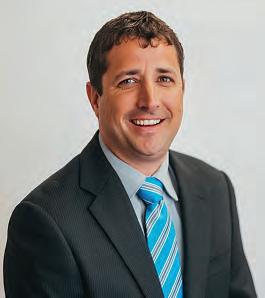
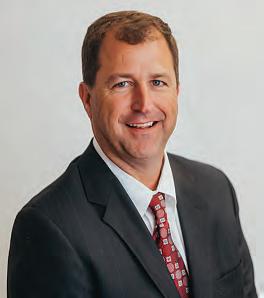



to make Minnesota a more consumer-friendly state for insurance.
“ There’s so much need for it and we don’t want to see it happening like it’s happening right now,” said Darian.
As for House of Insurance’s long-term future, the brothers have some ideas about where the business will go. They’ve also had conversations
about keeping it in the family, but like their parents, they want their kids to explore their own careers rather than feel like they need to carry on the family business. n
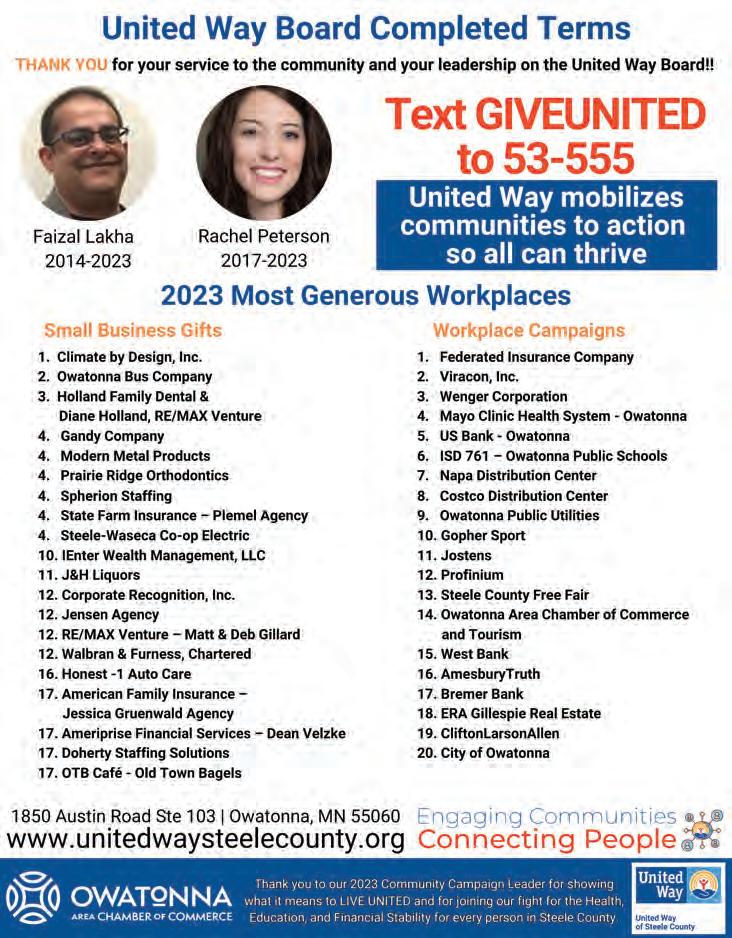

By JANE MOORE Guest Contributor
Mto many names throughout his life.
ulti-faceted and multitalented, Wyatt Bienfang of Le Sueur has answered
As a caring first grade teacher, Bienfang was known as “Mr. B.” To the students he guided and mentored in his job as a school resource officer, Bienfang was “Officer B.” During his three decades of involvement to date with the Le Sueur County Pioneer Power Association Show, Bienfang’s “B” stands for “blacksmith.”
“But my most important roles are as ‘D.A.D.’ to my kids, Cory and Amber Jae, and husband
to Susie,” said Bienfang, 63, who is also fatherin-law to Amy and grandfather to three lucky young girls—Elsie, 10; Aubrey, 8; and Fiona, 6.
For the past 30 years, the family’s bond has only grown stronger, thanks in part to Bienfang’s blacksmithing hobby and his clan’s willingness to support him in that pursuit at the three-day Pioneer Power Show every August since the early 1990s.
“My kids grew up around it, and they and Susie accepted the passion I found a long time ago for blacksmithing so we’ve been very blessed with this beautiful family time,” said Bienfang.
“Pioneer Power weekend is like Christmas for us. We all commit to it and love to be with each other, and on Friday night [of that weekend] when everyone’s sleeping at home, I have everything that really matters in life under one roof; it’s just precious.”
Fittingly, this “gentle giant” of a man—Bienfang stands 6’3 and was an offensive lineman as an undergraduate at Bemidji State University—now hails from Le Sueur.
For many years, Bienfang and Susie, his wife since 1985, made their home along Coachlight Road near Henderson. Bienfang says they could see the Rush River Bridge from their house.
Their property was situated in the Minnesota River’s flood plain, meaning they ultimately battled the impact of several floods while living there for over two decades. But it was the couple’s first flood cleanup effort that fortuitously introduced Bienfang to his primary avocation.
“ Tractors got stuck in the river silt all the time and I heard that horses were the only way
to put things back together,” said Bienfang. “Someone suggested we go to the Pioneer Power Show to talk to folks about it.”
Thus, in August 1993, Bienfang, Susie and their two young children ventured to the show grounds, where they were cornered in the crowd near the blacksmith shop during the extensive equipment parade.
Bienfang was far more fascinated with the smithing work than with the tractors cruising by, and chief blacksmith Robert Schleeve noticed Bienfang’s curious gaze.
“Robert saw me standing there and said, ‘Come here a minute,’” said Bienfang. Minutes of engagement turned into years, and Bienfang was mentored in the trade not only by Schleeve but also five other expert blacksmiths to whom he remains grateful.

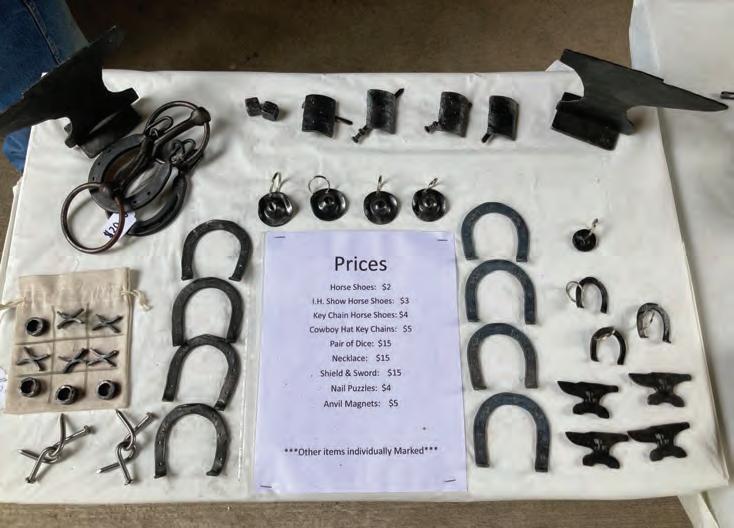
Products forged with fire are sold at the blacksmith shop Wyatt Bienfang and his family staff each year at the Le Sueur County Pioneer Power Show. (Jane Moore/southernminn.com) CONTINUED FROM PAGE 19
Though they have all passed on in the last several years, each liberally shared expertise with the adept and eager Bienfang.
By 2002, Schleeve handed leadership of the Pioneer Power Show’s blacksmith shop to Bienfang, willingly switching roles with his longtime
apprentice. What’s more, Bienfang now has his own forge at the non-flood zone property in Le Sueur where he and Susie were able to relocate in 2011, just six miles from their former home.
“ The Pioneer Power [horse] guys helped me put my property back together, and I got the beautiful gift of learning from and working with Robert and finding out what I was called
to do,” said Bienfang, who is known in the area for his metal-working skill and craftsmanship.
Daughter Amber Jae, a traveling R.N. based in North Carolina who prioritizes being present at the Pioneer Power Show no matter where her journeys take her, speaks glowingly of her accomplished father.
“My house is filled with things he’s made,” she said. “When people visit me, they marvel at it all. It’s really cool to be able to say, ‘My dad made that.’
“His talent, creativity and skill set are surprising. I always say he can fix anything, and he is so creative—he draws, sketches, paints, builds—all of that.”
Bienfang embraces his reputation as a “fixer” and is unfailingly happy to help.
“In a farming community, things get worn out—an ice pick, a mower—and I’ve welded and fixed many items, sometimes for a coffee cake or apple pie,” he smiled.
“It’s kind of a barter thing, and it’s a wonderful reflection of how we can use our time, talent and love.”
A graduate of St. Francis High School, Bienfang was the eldest of six children in a farming family. He attributes his birth order to fostering a nurturing/mentoring instinct that’s key to his character.
But while he always possessed a strong work ethic and excelled in the arenas of art and imagination, school was occasionally a struggle for him.
“I didn’t spell well as a kid,” admitted Bienfang. “If I was called to the board to spell a word, I’d draw a picture instead. My strengths were in creativity and art.”
Not every teacher viewed that charitably; his variable school experiences prompted Bienfang to pursue elementary education as one of two majors (his second major was law enforcement) while attending Bemidji State on a football scholarship.
“I’ve told my grandkids, ‘Grandpa became a teacher because I didn’t care for school,’” he said. “I was going to do it better; I didn’t want kids to be scared to go to school. You have to meet them where they are.”
However, with a full slate of college classes, bouts of homesickness and weekly drubbings on the gridiron, Bienfang again found himself scrambling to manage the load, especially during his first semester of college.
Sister Andre (Clara) Marthaler, a professor he calls “an angel from God,” pointed him in the right direction during a heart-wrenching one-on-one meeting.
Empathetic yet emphatic, Sister Andre essentially told Bienfang he could make it but the road wouldn’t be easy.
“She said, ‘Well, I’ll tell you, Mr. Wyatt Bienfang: Unless you put in the time and effort, school does not happen, but I’ll have faith in you and we’ll have to do this together,’” he recounted.
With Sister Andre’s counsel and assistance, Bienfang persisted.
A newly married college graduate with a teaching degree in hand, Bienfang encountered a new obstacle: the former football player didn’t fit most administrators’ pre-existing notions of what a first-grade teacher looked like.
“Arlington-Green Isle took a chance on me,” recalled Bienfang, “but the principal wasn’t crazy about me.”
Bienfang’s effort and enthusiasm eventually won over that principal — Zelora Lentz, who died in June 2020 at 90.
“She turned out to be a great person in my life,” said Bienfang. “She became the peer mediator for me when I was earning my master’s
degree, and I did the eulogies for her and her husband Austie when they passed.”
Even as Bienfang endeared himself to first graders and their parents in his 14 years of teaching, he put his law enforcement education to use and moonlighted as a part-time police officer in Arlington and a few other surrounding small communities.
“I was on the squad about one night each week, and when I was a football coach and it was Halloween, I told the kids they better behave because Coach B was about to become Officer B,” he laughed.
With two active children, a wife who also worked in the education system, a full-time teaching job, part-time police work and blacksmith development, life was increasingly hectic for Bienfang.
It was Susie who laid down the law and suggested he should choose between being a cop or a teacher, as Bienfang put it.
“In 1999, I took a three-year leave of absence from teaching to become the school resource officer in Glencoe,” said Bienfang. “When I saw the job description, it seemed like a perfect combination of my tender heart for teaching and knowledge of protecting children.
“God had built me for that position, so I stayed there [until retiring in 2018] and helped at all the schools, helping kids who were lost, who were at risk, all the things that go along with that journey.”
Professionally, Bienfang was involved in many difficult CHIPS (Child in Need of Protection or Services) cases.
“You have to risk more of yourself than you ever planned on,” said Bienfang. “Finding kids who are lost in the darkness is a hard calling, and you have to be invested in what’s going on because kids know if you mean what you say or if you’re just going through the motions.”
Jim Raiter, a retired Glencoe police officer and chief, was on the hiring team that brought Bienfang on board in the late 1990s.
“We became friends, and then close friends, and Wyatt is like family to me now,” said Raiter. “Wyatt is very passionate about making life better for kids and their families.
“He’s always been there for me, both personally and professionally. He’s a guy you can always count on.”
Raiter also had a firsthand view of Bienfang’s evolution as a blacksmith.
“Wyatt’s artistic ability is simply amazing,” said Raiter. “He’s a very humble guy who’s kind of perfected his practice through trial and error. I help him with different projects from time to time and he’s very good at that stuff.”
At last month’s Pioneer Power Show, Bienfang comfortably inhabited the burnt-red building housing the blacksmith’s shop.
Dressed in a short-sleeve chambray shirt, jeans and black-tinged Tillman welding gloves, Bienfang easily moved between demonstrating skills for a pre-adolescent boy to chatting up an old-timer who stopped by to tending the fire in the forge to teasing his granddaughters, who cheerfully staffed the sale table.
Neatly displayed on the table were various metal wares, including cowboy hat keychains crafted by Bienfang’s wife Susie, decorative pieces, miniature Christmas trees, hooks and necklaces.
“ The necklaces are our best-selling product,” said Amber Jae, gesturing to the crosses, hearts and horseshoes, all made either by Bienfang or an apprentice.
Bienfang honors the wishes and traditions set forth by his predecessor, Robert Schleeve.

Necklaces are top sellers at the Bienfang blacksmith shop. (Jane Moore/southernminn.com)


Before Schleeve died, he’d met with Bienfang and asked him to continue selling the horseshoes for minimal cost—typically $2—because Schleeve loved to let kids feel the buying power of a $5 or $10 bill, hoping they’d still have change left over to purchase a malt after choosing a more lasting souvenir.
“As long as I’m the blacksmith at Pioneer Power, or my son Cory after me, we’ll honor that for Robert,” said Bienfang.
Another Schleeve tradition was breaking at 3:30 p.m. on each day of the Pioneer Power show to head to the milkshake stand by the horse barn.
“We call it ‘Robert’s time,’ and they make a special raspberry chocolate flavor for us,” said Bienfang. “We laugh, joke and celebrate with milkshakes. Robert used to do that to say thank
you to everybody.”
Bienfang has served as vice president of the Pioneer Power Association board for two years and has additionally taught and volunteered, along with his wife, at FarmAmerica near Waseca. Giving back and paying it forward are as natural to Bienfang as expressing his creativity.
“I’ve learned I just have to be a light in the darkness, after watching death and bad things happen [as a police officer],” Bienfang said.
“I don’t know how people get through without having faith.”
Bienfang is thankful for those who mentored and encouraged him in his life, and he never forgets a good turn.
He’s placed one of his forged crosses on the gravestone of Sister Andre, who died at age 93 in 2010.
“I did that to say goodbye, and to say thank you,” said Bienfang. “We have to be so grateful.” n
Jane Turpin Moore is a freelance writer. Contact the editor at editor@apgsomn.com.



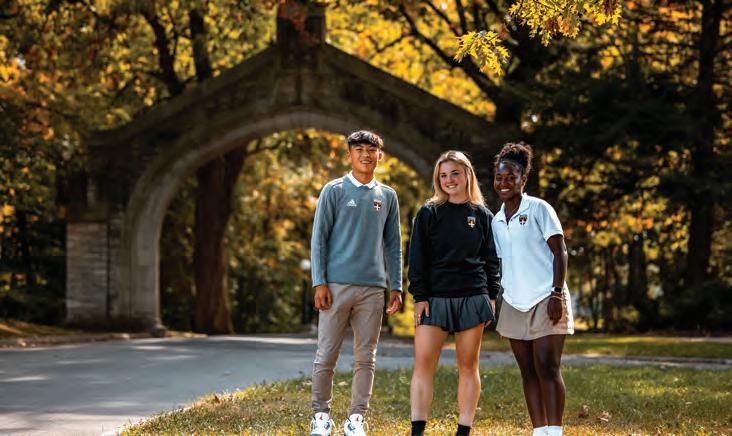

By ANDREW DEZIEL andrew.deziel@apgsomn.com
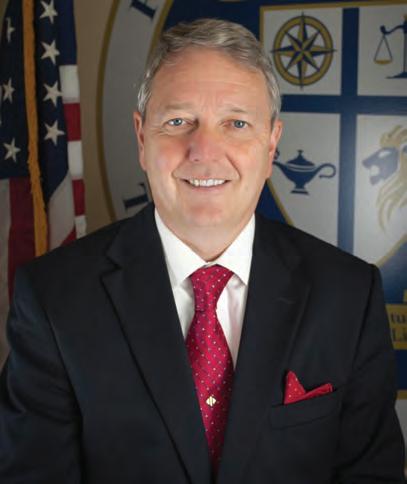
After a long career in public service which saw him meet with many of the most prominent leaders of his generation, Mikhail Rostislavovich has now devoted himself in “retirement” to giving back as much as possible to his adopted hometown of Waseca.
From President of the Exchange Club to Vice President of the Waseca Area Chamber of Commerce’s Board of Directors to Vice President of the Waseca Art Center, Rostislavovich occupies a variety of highly visible roles in a community he moved to just three years ago.
Rostislavovich says his active community involvement is the fulfillment of a commitment he made years ago during his long career of public service, which saw him work for many of Minnesota’s most prominent political leaders of his era.
“When I was 40 years old, I promised myself that because of all of these opportunities I’ve had, that I would take those opportunities and give that back to my community that I lived in,” Rostislavovich said. “Working 40 hours for the different groups that I work for is a blessing for me.”
Raised on a family farm near St. Peter after being adopted into a large family of Norwegian descent, Rostislavovich attended secondary school at St. James Academy in Faribault, a then military academy that is now part of the Shattuck-St. Mary’s School.
Rostislavovich’s time at St. James made a significant impact on his life, drawing him toward a lifelong relationship with the Episcopal Church, with which Shattuck-St. Mary is affiliated, and piquing for the first time his interest in political matters.
When Rostislavovich was on campus, the Vietnam War was in full swing, though by the time he graduated and turned 18 it had ended. He recalled seeing protests against upperclassmen who had gone to fight in the war, and too often tragically came back in caskets.
“Seeing the protests going on outside of our school, protests against upperclassmen who gave their lives and came back had a major effect on me,” Rostislavovich said. “I looked to see who caused the war, who’s ending up with the problems of the war, what’s causing this upheaval.”
The experience led Rostislavovich to become involved with the local Republican Party. At the age of 19, he volunteered for the 1978 U.S. Senate campaign of Rudy Boschwitz, who won by a large margin as Republicans swept the major statewide races that year.
For the first few years, Rostislavovich’s work in the political arena was strictly as a volunteer and local party officer. Though he might not have been paid for the work, it did open the door for him to meet and befriend a number of influential conservatives.
Among them was future Minnesota Supreme Court Justice G. Barry Anderson,
who retired in May after nearly two decades on the Court. An appointee of Gov. Tim Pawlenty, Anderson was at the time of his retirement the last member of the court not appointed by a DFL Governor.
Rostislavovich and Anderson met in the early 1980s as volunteers and activists within the Second Congressional District Republican Party. At the time, the District covered southwestern Minnesota and had just elected an up and coming Republican Congressman named Vin Weber.
At the time, Anderson was practicing law in Fairmont while serving as a local Republican party leader. Later, he would move to the Twin Cities and build an extensive legal resume before Gov. Arne Carlson tapped him to serve on the Minnesota Court of Appeals in 1998.
Anderson said that Rostislavovich was a particularly effective organizer because it was clear that he genuinely cared about the volunteers he worked with, staying in close contact with one passionate volunteer even as her health declined.
“(Political work) sometimes has a bad image in press coverage, but at the end of the day it’s all about interaction with people,” Anderson said. “From my perspective, it illustrates his commitment to individuals over and above and separate and apart from political activity.”
Rostislavovich began his career well away from politics, working as a therapist to adjudicated adolescents for several years at what is now the St. Peter Regional Treatment Center. While he stuck with that job for several years, he said it was extremely taxing.
“ That job was really wearing me down,” Rostislavovich said. “I was not good at leaving my work at work.”
By the late 1980s Rostislavovich was looking to make a career change, and his organizing skills had caught the attention of Congressman Weber, who during the Reagan era became one of the most influential members of the House Republican Caucus.
In 1988, New York Congressman Jack Kemp decided to challenge Vice President George H.W. Bush and Sen. Bob Dole for the Republican Presidential nomination, and looked to Rep. Weber, a strong ally and supporter, for advice on who he might hire to staff his campaign in Minnesota.
Weber recommended Rostislavovich, and after an interview in Washington Kemp was sufficiently sold on the young activist to hire him as his Minnesota Field Director. He was
later given regional responsibilities and worked on Kemp’s campaign in the Iowa caucuses.
Though Kemp was a key architect of President Reagan’s signature supply side economics policy, he suffered from a lack of national name recognition and would have been the first member of the House of Representatives to directly ascend to the White House in over a century.
While Kemp’s Presidential campaign struggled to gain traction, Rostislavovich’s political career did not. He would spend the next two decades as a full-time campaign staffer, working for Rep. Weber, Sen. Rod Grams and Govs. Carlson and Pawlenty.
While working for Minnesota’s most prominent Republican politicians, Rostislavovich had the opportunity to travel to many different parts of the world on “junkets,” staying at U.S. embassies throughout the world and enjoying some very unique experiences.
“You got to experience some really wild things that you would never think of having to do, particularly with cuisine,” Rostislavovich said. “Some of the things I was forced to experience really expanded my understanding, and when you understand people’s cuisine you can understand them a little bit better.”
As a liaison for his bosses and as a staffer at the Twin Cities-based conservative think tank Center of the American Experiment, Rostislavovich also met with many different world leaders, including Margaret Thatcher, Mikhail Gorbachev, Lech Wałęsa and Benjamin Netanyahu.
Rostislavovich said he was particularly grateful for the opportunity to meet with such prominent world leaders and get to know a little bit about what they really were like behind the carefully constructed and typically highly polarizing public facade and image.
With the high flying contacts came an incredibly grueling work schedule. In contrast to a typical 9 to 5 job, Rostislavovich said that politicians and their staffers are typically on the go during nearly all waking hours, with only limited opportunities for rest and relaxation.
“People don’t realize how hard their jobs are,” Rostislavovich said. “They go sometimes from 5:30 to 10:30, 11 o’clock at night. When you’re a staffer with them, you’re working those hours too. And it’s not just Monday through Friday, it’s Monday through Sunday.”
Rostislavovich said he never considered running for office himself, citing the intense microscope which a candidate’s every statement and action is placed under along with the vitriol and even security threats which prominent elected officials face on a daily basis.

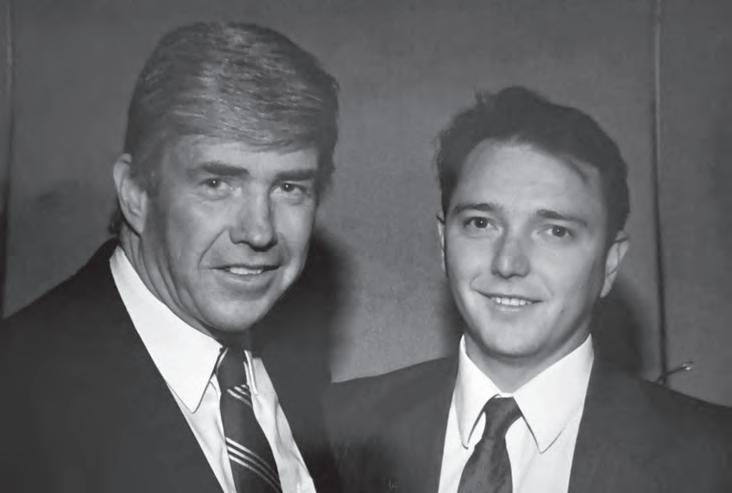
ABOVE: Mikhail Rostislavovich got his start in politics by working for the Presidential campaign of Congressman Jack Kemp, an architect of President Ronald Reagan’s supply side economics policies (Submitted Photo).
RIGHT: Israeli Prime Minister Benjamin Netanyahu is the rare leader Mikhail Rostislavovich met during his political career who is still active. (Submitted Photo)




and host a fundraiser for Rep. Brad Finstad.
“I wouldn’t want that for a million dollars,” Rostislavovich said. “You’d have to have a personality and ego as big as this house to put up with that kind of stuff.”
Since stepping down from his position with Gov. Pawlenty, Rostislavovich largely retired from the political scene, though he has come out of retirement a bit this year to help manage the state legislative campaign of Tom Sexton
Instead of politics, Rostislavovich has thrown his heart and soul into community organizations, first in St. Peter and now in Waseca. For several years he worked with the Royal Family Kids Camp, a special camp tailored to the needs of foster kids in southwestern Minnesota.
Rostislavovich also served on the Board of Directors of Reins of Hope, a nonprofit which seeks to help kids with autism and epilepsy by providing “equine assisted” forms of therapy, which many have found to be remarkably effective.
A major history buff, Rostislavovich also

and restoring them to their former glory. That led the two to Waseca, where they would fix up the historic Moonan house along State Street.
Waseca Area Chamber of Commerce Executive Director Ann Fitch noted that after moving into town, one of Rostislavovich’s first stops was at the Chamber office to see how he could get involved. She recalled suggesting the Historical Society and the Art Center, among others.
Fitch particularly praised Rostislavovich’s leadership at the Art Center, which she said has been enhanced “tenfold” by his leadership. In addition to his tireless community involvement, she said that Rostislavovich has become a great friend to her and many other community leaders.
“For a newcomer coming into your community he sets the bar pretty high,” Fitch said. “He really does live service above self.”
Gov. Pawlenty said that Rostislavovich’s enthusiastic commitment to serving his local community in retirement is a continuation of the approach he took towards public service over his career as a political aide.
“Even back then, he seemed he always seemed like a cause oriented person,” Pawlenty said. “He had a real interest and passion for serving, for the betterment of Minnesota.”
Even though he’s something of a newbie to town, Rostislavovich said that he’s been embraced more warmly in Waseca than anywhere else he’s ever lived. He said that the warm authenticity of Waseca is a welcome contrast to politics, where friendships can be fickle and short-lived.
“In politics, you get to meet all of these major movers and shakers in the state and they’re your best friend, but the minute the person you’re working for is out of office the friendship ends,” Rostislavovich said. “In a small town like Waseca, when you make your friendships they’ll last a lifetime or as long as you want them to.”
served as longtime Vice President of the Nicollet County Historical Society and ran the E. St. Julien Cox House in St. Peter, preserving the carpenter gothic home built for St. Peter’s first mayor for future generations.
Rostislavovich also became increasingly involved with his church, serving as a verger at the Church of the Holy Communion. He was later hired by then-Bishop Brian Prior to serve as a liaison between the Episcopal Diocese of Minnesota and churches across the state.
Along with his brother, Dwight Tostenson, Rostislavovich cultivated a passion for buying beautiful homes which had fallen on hard times
Rostislavovich said that he has every intention of staying in Waseca and remaining as active as possible in community organizations for as long as he can, describing the community as a gem which often goes under appreciated even by its own residents.
“From my perspective, Waseca is southern Minnesota’s Lake Minnetonka,” Rostislavovich said. “We’ve got beautiful lakes, bike paths, parks, the Art Center, the theater; we have everything here that any other really prominent place has. The difference is that people here are warmer and more caring.” n
Deziel


Zollner poses with just a small sampling of the many community and volunteer-based t-shirts she had collected over the years in Owatonna. As a “semi-retired” graphic designer turned preschool teacher, Zollner has been dubbed “Owatonna’s mom” by many. (Annie Harman/southernminn.com)
By ANNIE HARMAN annie.harman@apgsomn.com
It seems everywhere you turn in Owatonna, you’re bound to run into Gail Zollner.
The running joke in her household is there is always somewhere to go, something to do, and somewhere to be. The “semi-retired” is constantly busy, and it has become no surprise that people view her as a sudomother.
Especially because, like most mothers in the world, Zollner doesn’t do what she does for recognition; it’s simply ingrained in her DNA.
“Retire? Nah — I can’t sit at home,” Zollner laughed as she recalled her 2021 retirement from the graphic design department at Federated Insurance, where she had spent her entire 35-year career. “I have a busy brain … I am happy ‘doing,’ happy being involved. It’s just what I do.”
And what she does? It’s a lot, ranging from church activities to involvement in the local arts community to giving a hand to the local figure skating club, not to mention her hours upon hours upon hours of 4-H leadership.
And she has been doing it all so long that she can’t help but giggle when trying to figure out when or how it all got started.
Zollner first moved to Owatonna with her family when she was only 6 years old, noting her parents, Harry and Joyce Betterman, found their “forever home” new Trinity Lutheran Church.
With an artistic mother, Zollner said she grew up watching her mom construct wedding dresses — at least a dozen in her lifetime — as well as fill their home with music.
“We got to do one thing, and I wanted piano lessons,” Zollner recalls. “We had this piano in the basement, an old upright, that we painted blue and rubbed off with black.”
From second to eighth grade, Zollner said took lessons to help her learn the basics as well as some popular songs. At the time she claimed she “didn’t need Beethoven.” That was

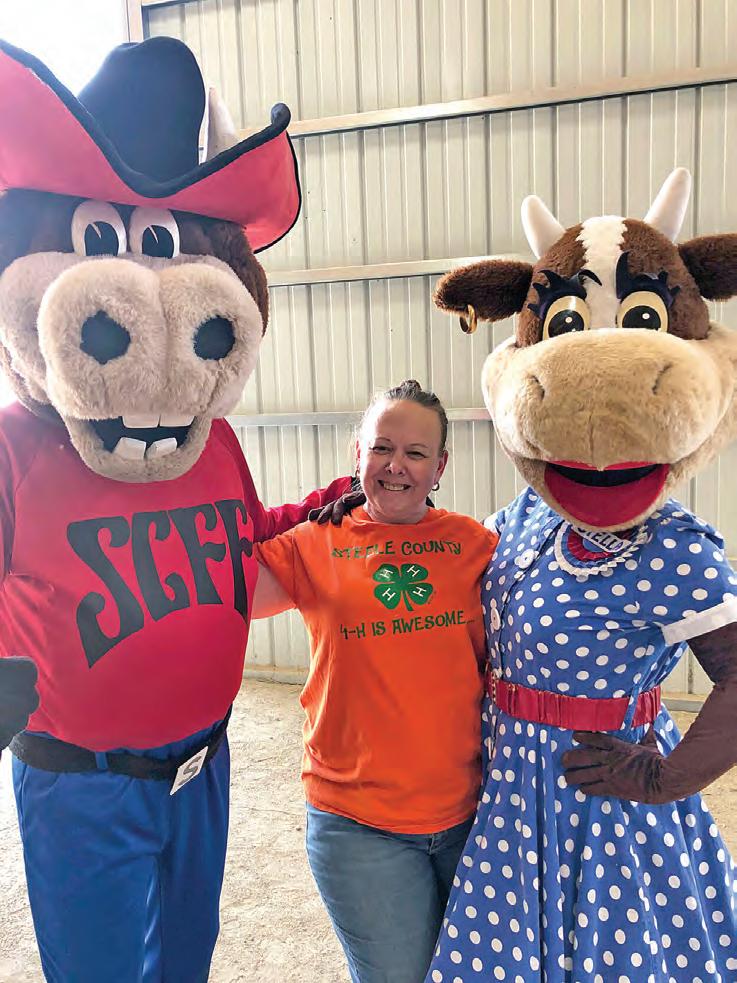
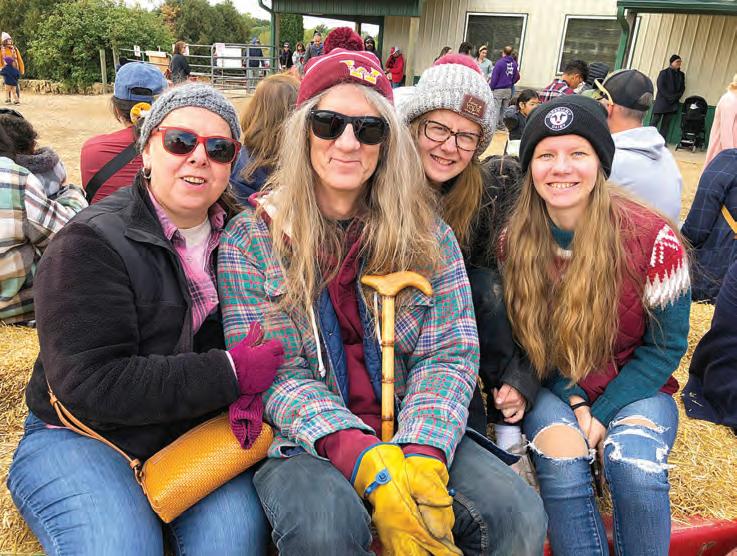
CONTINUED FROM PAGE 25
until she became an adult, and decided she was ready to play again.
Today, that same piano Zollner learned to play on sits in her living room after he paid to have someone refurbish it. She can now play Beethoven, church music and a variety of other tunes, thinking of her mother when music fills the air.

ing, and had a passion for gardening and being an all-around “handyman,” including remodeling houses and building wooden toys.
Her parents also loved to dance, chartering the Steele Steppers Square Dance Club.
Between their variety of interests and Zollner taking many trips up to her paternal grandparents’ farm in central Minnesota, she claims she was born with 4-H in her blood, despite never being a member herself.
“I grew up in 4-H without ever having 4-H,” she laughed.
The foundation growing up is what prepared her and her husband, Mark Zollner, to enroll her daughters, Becca and Lilly, into 4-H when they were old enough, an obvious choice after watching the girls fall in love with “Cow Camp” through Early Childhood Family Education (ECFE) via Owatonna Community Ed.
Joining the “Pratt Commandos” 4-H club, Zollner’s summertime schedule quickly revolved around all things 4-H. While her girls were still a part of the program, she jokes she was able to “fend off” becoming a leader as she was already so busy being involved in their projects.
“We basically would show up and live at the fair,” she chuckled.
Now that her kids have grown out of the program and she has taken on the role of club leader, teacher and overall volunteer, when the Steele County Free Fair rolls around each year, she still lives there for the full week.
After she no longer had her own children enrolled in 4-H, Zollner was invited to an organizational meeting for the Pratt Commandos, “just to see what it was about.”
attended a Steele County American Dairy Association meeting, she left a volunteer and continues today as a board member and “princess coordinator” — most recently helping Afton Nelson with her competition at the Princess Kay of the Milky Way pageant.
When she retired from Federated, the leaders at Trinity Lutheran Church helped if she could fill in a couple mornings a week as a teaching assistant for the preschools. Already volunteering in a number of ways at the church, and not wanting to be a sit-at-home retiree, Zollner was happy to say yes. Two years later that turned into a long-term substitute position for the month of January, and by the end of the year they asked if she would be willing to take on a classroom full time.
“It just keeps happening,” she said between chuckles. “I am in my career 2.0.”
But for anyone who spends any time with Zollner, it is clear the decision to be involved in so many ways, giving herself to others, is what makes her happy. During the interview for her feature, Zollner was interrupted multiple times by small kids who had her as a teacher, a 4-H leader, or have encountered her in the numerous other ways Zollner volunteers, wanting to say hello and embrace the woman.
“I am paid in hugs,” Zollner said, beaming with emotion as she waved goodbye to two small girls who approached her in the coffee shop.
It’s not just the kids, either, who are forever drawn to Zollner after interacting with her once. The adults she works alongside, whether in a volunteer or recreational capacity, also keep her close to their hearts.
Aside from the artistic and musical nature she developed from her mother, Zollner said her “stay busy” mindset was inherited from her father, an Army veteran who worked in the drafting department at the Owatonna Tool Company, a place Zollner has fond memories of growing up, looking over his layouts and designs. He also was involved in a variety of recreational leagues, such as tennis and bowl-
“ That was seven years ago — I’m slowly working toward becoming just a volunteer again,” Zollner laughed.
Luck would have it, many of Zollner’s volunteer opportunities seem to happen by her agreeing to attend a meeting and then her becoming an integral part of the organization or group.
When one of her daughter’s wanted to take a go at figure skating, Zollner joined the board of the Owatonna Figure Skating Club, volunteering to make their show graphics. When she
“I love her — it’s honestly hard to put into words what she means to me,” said Holly Jorgensen, one of Zollner’s many friends she has met through community involvement.
The two women first encountered one another through the Little Theatre of Owatonna — another area of the community Zollner is heavily involved in as a volunteer — when their daughters were in a show together. As the kids became friends, the adults naturally followed suit, and soon they were starring in shows
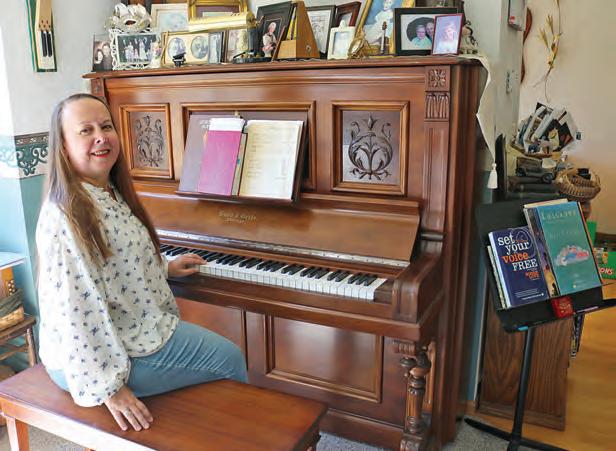


LEFT: Gail Zollner sits at the same piano she learned to play on in the second grade. She credits her mother, Joyce Betterman, for raising her in both an
household, while her father, Harry Betterman, showed her the framework of a happy and busy life.
“smile fairy” for friend Holly Jorgensen’s nonprofit, Let’s
during the
(Submitted
alongside one another as well.
“We spent a lot of time in the green room together, especially during musicals, practicing the dance routines, and Gail would help me a lot,” Jorgensen said, noting she does not have a dance background where Zollner does. “She’s so patient, and always right there, ready to help regardless if you ask.”
Their friendship expanded beyond backstage, with Jorgensen being one of many people to dub Zollner as “everyone’s mom.”
“She is someone you can be silly and goofy with, just like a mom, but yet she is caring and compassionate, just like a mom,” Jorgensen said. “We have had a lot of those tough or heavy


conversations. Gail is the type of person who lifts others up all the time.”
As Jorgensen’s own nonprofit, Let’s Smile, continued to expand over the years, it was natural for her to reach out to her friend to ask for help in spreading awareness for the children’s dental health program, targeting underinsured and uninsured families.
“If Gail is available, she is always more than willing to help,” Jorgensen said. “She makes a great smile fairy. She is so friendly and engaging with the kids and truly helps spread smiles.”
But once again, Zollner said this is just how she is, it’s just how she is wired.
“I will do this, all of this, as long as I can,”






Zollner said, as she maneuvered past the school supplies the Quilting Club — another volunteer group she is a part of and simply “forgot” to mention — will be donating this fall. “A lot of kids don’t know how to sew, but I can teach them. There’s no play this fall [at LTO], so I figured I could teach a Community Ed. class.”
She will actually be teaching several classes, including sewing, paper origami, and small clay sculptures at the Owatonna Arts Center, where she volunteers as a graphic designer for their newsletter.
“She does such a variety of different things, and just like everyone’s mom — or the mom everyone wants to have — she is teaching like
and
skills,” Jorgensen said. “She is making a very lasting, very powerful and positive impact on her community.”
And as Zollner puts it herself, that is just what makes her who she is: a woman determined to turn every gathering into a warm, welcoming space. With a heart as big as her smile, Zollner’s caring nature and selfless acts make her the glue that holds a community together.
She may never seek the spotlight or accolades, but what mother ever truly does? n Reach Associate Editor Annie Harman at 507-444-2378. ©Copyright 2024 APG Media of Southern Minnesota.














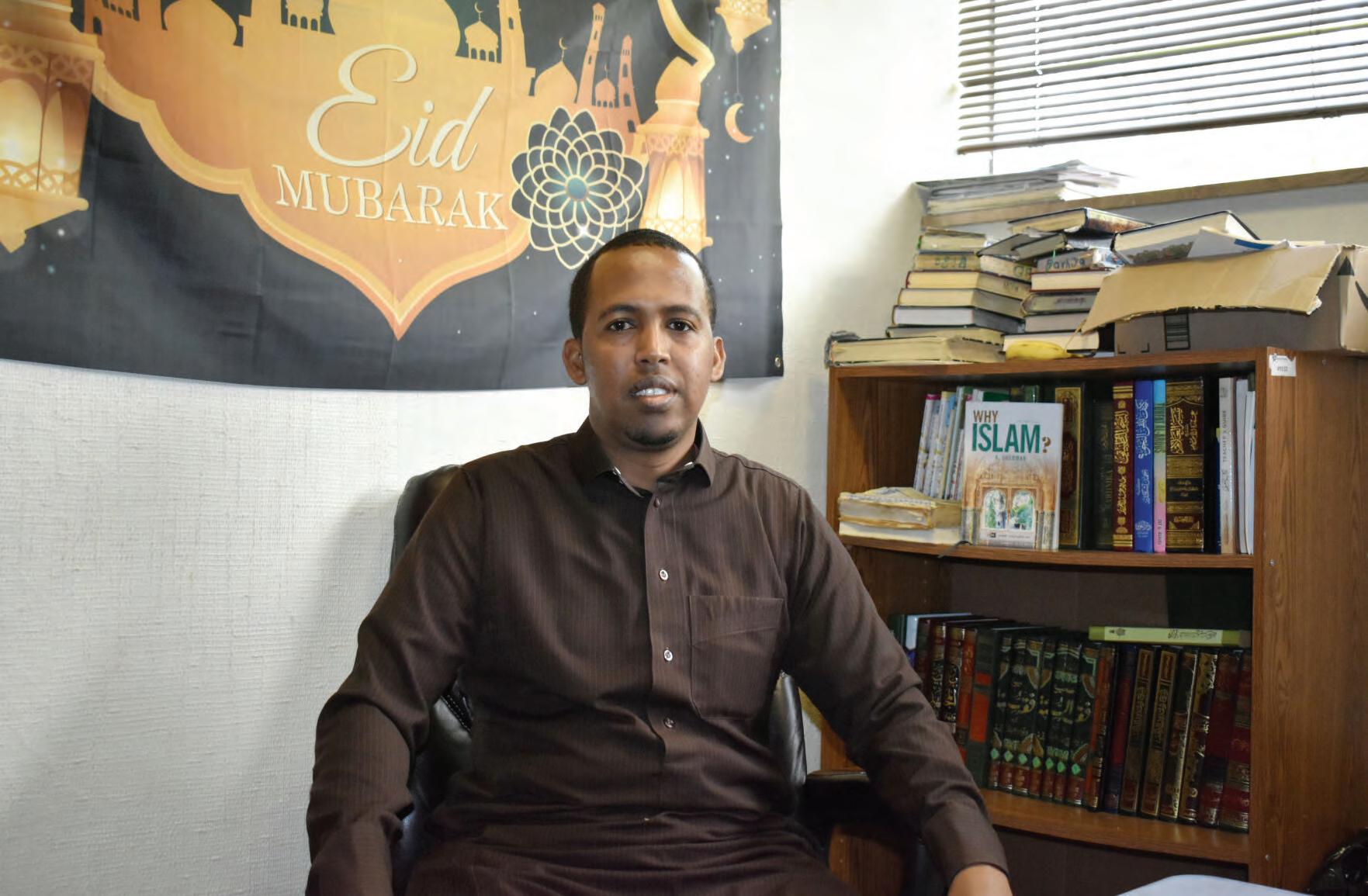
By COLTON KEMP colton.kemp@apgsomn.com
Peanut butter was a revelation for the young boy in war-torn Somalia, a taste of a world beyond offered by a foreign, pale-skinned people called Americans.
Not soon after the American Intervention of 1994, Bashir Omar found himself running from his homeland to Nairobi, Kenya. Thirty years later, the Faribault resident guides those on the same path through an unfamiliar system as the cultural liaison for Faribault Public Schools.
He came to the country as a teenager with his parents in 2005. He was sponsored by his sister who lived in Bloomington.
“One of my relatives lived in Faribault, and they told us that ‘There’s a small town here that you can live, and your children can go to school here, and it’s easy to navigate the streets and the town,’” he said. “That’s how we ended up coming here.”
He attended Faribault High School while
working part time at KFC making $6 an hour. After graduating, Omar took generaleducation courses at South Central College, then studied business administration at Brown College in Mendota Heights.
During his studies, he remained in Faribault, often volunteering at the local mosque, Abubakar As-Saddique Islamic Center. He taught the mosque’s youth about the Arabic alphabet and other important cultural topics. Admittedly, they also occasionally hooked up the PlayStation to the projector.
“I preached to the kids to stay away from drugs, stay away from anything that can harm yourself or your family or that can land you in jail,” he said. “They learned about the Prophet. We teach them all the prophets — Abraham, Noah, Jacob, Muhammad — all about the testament.”
For a while, he worked as an interpreter for Allina Health, then landed a full-time job working for the school district as the cultural liaison.
“We’re not just an interpreter,” he said of his current position. “We teach them about the school system. ‘What’s a GPA? What is
Whatever that you put out to the world is what you get. I think it’s my obligation that I have to help them and work with them. It’s something that I like doing. I ask forgiveness from God. The more you help, the more He helps you. Just change the lens, you know? Think, ‘What can I do for others?’ instead of ‘What do I need for myself?’ ”
- Omar Bashir
the school system? What are these letters?’
Like how a teacher grades: A, B, C, D, F. We’re dealing with parents who have never even had a first-grade education. The families, some of them are learning how to write their names.”
He said the cultural liaisons wear many hats in their role, and there’s plenty for newcomers to learn. “In Africa, you send your children to school, and the teacher will take care of it,” he said. “There are no conferences; it’s a totally different system. It’s like ‘The teacher will take care of it.’ Any issue, ‘The teacher will take care of it.’ Behavior problem? ‘The teacher will take
care
teachers. There, we’d never question the teacher.”
If there was a course he could offer or create at the school, he said it’d focus on technology.
“Coding, robotics, cryptocurrency, AI, even keyboarding skills too,” he said. “Kids need to be taught about these things, so they know what’s going on. Because that stuff is always changing.”
Omar has lived in Faribault about 15 years now. He’s made an impact on his community, even earning an Outstanding Refugee of the Year Award from the Minnesota Department of Human Services in 2019.
He has served as president of the Faribault Diversity Coalition, and sat on the board of several organizations around town. He still volunteers at the mosque, where he has his own office.
Sometimes, when a new immigrant family arrives in town, he’ll drive them to Mankato to get a social-security number for no pay, and no reward. He does it because it’s what his religion says to do, and because he feels it’s the right thing to do.
For instance, he recently learned that a newcomer’s ID had the incorrect birthday on it. Without hesitating, he called an immigration lawyer and helped them get it fixed.
“Whatever that you put out to the world is what you get,” he said of charity, one of the five tenets of Islam. “I think it’s my obligation that I have to help them and work with them. It’s something that I like doing. I ask forgiveness from God. The more you help, the more He helps you. Just change the lens, you know? Think, ‘What can I do for others?’ instead of ‘What do I need for myself?’”

Omar said he’s happy in Faribault, calling it a very welcoming town. He said, aside from being told to speak English in public a few times, he’s not faced much outright racism, noting that he doesn’t like to focus on the negative.
“It’s a very welcoming place,” he said. “The


negative is very tiny; it’s very small. So if we focus on that little, tiny negative thing, then we’re gonna forget about the good things, the positive. So I can come here to the mosque at 3 a.m. or 2 a.m. here, and no one is gonna stop me. I’m practicing my religion, worshiping God and coming here, and no one is stopping me. So that’s a good thing. I have the freedom of
religion in America. But if a guy was walking by or driving by and gives me a middle finger, I don’t care.”
He still feels the mainstream media could do a better job.
“ There is a big assumption in the media
CONTINUED ON PAGE 30





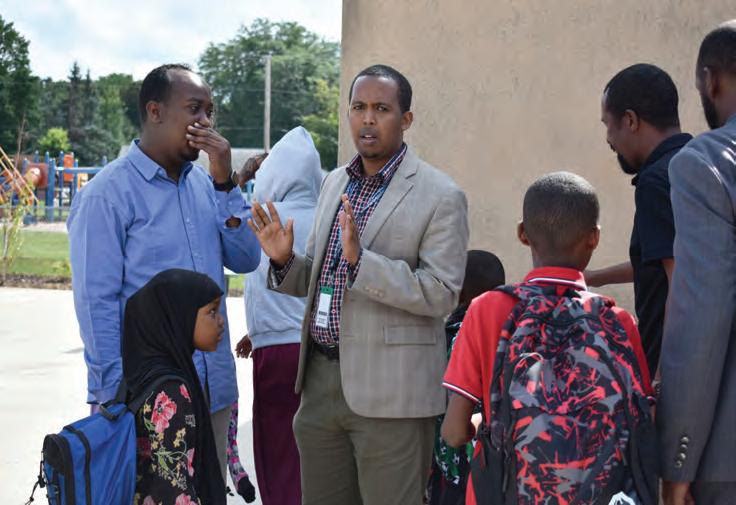
that all these refugees, or all these immigrants, they’re coming here to take over your job, they want to kill you or they want to do something to you,” he said. “But that’s not who we are. And you can see that. I mean, we’ve lived here more than 25 years.”
There are hard times for Omar personally, challenges he sees as tests.
For example, he still has to fly to Nairobi to see his wife and kids. While his children are American citizens, he doesn’t want to separate them from their mother, who hasn’t yet gotten through the challenging, tedious immigration system.
“ That’s partly why I like working for the schools,” he said. “You get two months off. You don’t get that at any other jobs.”
More than a dozen background checks, DNA tests and more have stood in the way of their reunion. After several years, they’re getting close, but still aren’t quite there.
“It’s sad,” he said. “They say ‘It’ll take about
There is a big assumption in the media that all these refugees, or all these immigrants, they’re coming here to take over your job, they want to kill you or they want to do something to you. But that’s not who we are. And you can see that. I mean, we’ve lived here more than 25 years.”
- Omar Bashir
a year,’ and it’s taken almost six. It shouldn’t take this long. I even talked to the senator, Amy Klobuchar. I asked her to talk to the embassy. I talked to Tina Smith. Nothing happened. It’s sad. That’s maybe another story.”
He explained the real reason for the long wait is a lack of embassies in east Africa.
“Different embassies have different policies, but the embassy in Kenya is totally different,” he said. “I believe if my wife went to a different embassy — let’s say, an embassy in Rwanda or maybe South Africa, or maybe in Djibouti or in India, or in Malaysia — I am sure she would have been here a long time ago. But over there is the problem. Somalia does not have an embassy. Uganda does not have an embassy. All people go to Kenya.”
With that many refugees and immigrants, all there is left for him to do at the end of his trip each summer is say goodbye.
“It’s sad; it’s terrible,” he said. “I cry when I leave my family. It’s very, very painful to say goodbye to your wife and your children. I don’t want to take my children away from my wife. I’m sure they can come with me, because they already have their US passport. But I’m waiting for my wife’s visa. It’s been a good lesson for me.” n




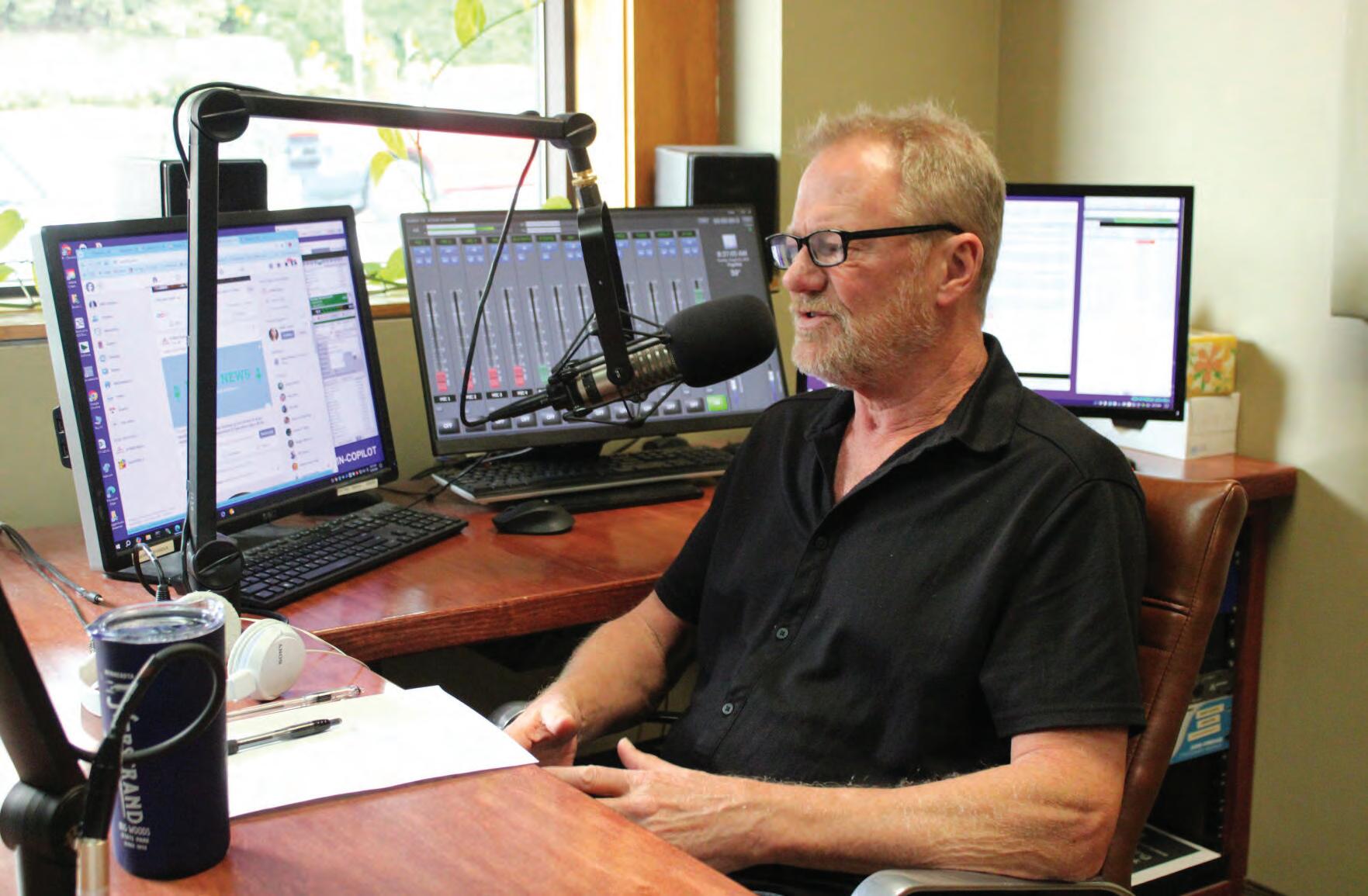
By PAMELA THOMPSON pamela.thompson@apgsomn.com

Inside the downtown KYMN Radio studio, an old station sign from Waterford hangs on one wall; the light from the top of the radio tower that still glows red sits next to a seating area; past treasurers like microphones and old photos decorate the comfortable office space.
Two broadcast studios face out toward Division Street, allowing the public a glimpse inside a media operation that is near and dear to Northfielder listeners young and old.
At the end of this month, a staple of the station, Jeff Johnson, will be leaving the building — and the business — when he officially hands off ownership of Northfield’s only radio station to his friend and colleague, news director Rich Larson. Logan Wells will take over as the station’s news director.
Northfield talk radio fans who have been accustomed to waking up to the golden voice of “Morning Jeff” will have to reset when Johnson signs off the air at the end of September.
Johnson, who joined KYMN Radio when he bought the station in September 2008, officially took ownership on Jan 1, 2009. Since then, Johnson estimates he’s probably conducted somewhere between 15,000 to 20,000 interviews in his 30 years on the air.
He said his interview style was always conversational, not confrontational. “I want people to discuss a topic, not confess a secret,” he said.
After October 1, Johnson will silence his deep, rich radio voice as he rides his motorcycle off into the sunset — or geographically speaking, south through Mexico to Central America.
“ There are things I want to do next that don’t involve radio,” said Johnson. Besides traveling south on two wheels, Johnson has loaded his Kindle with lots of books including Minneapolis native John Olson’s poems and novels.
During Johnson’s long tenure at the microphone, he has few regrets, but he said he wishes he could have interviewed a U.S.

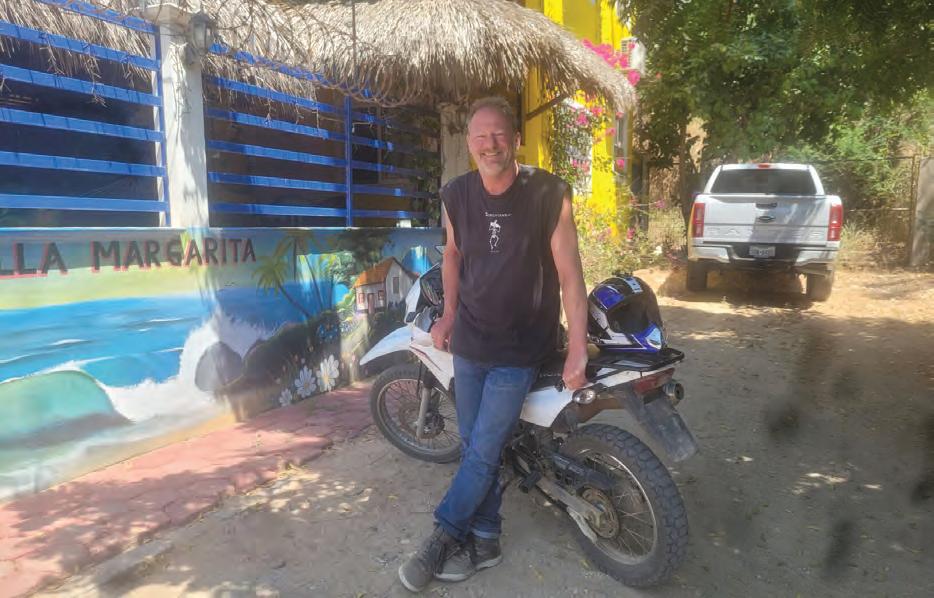
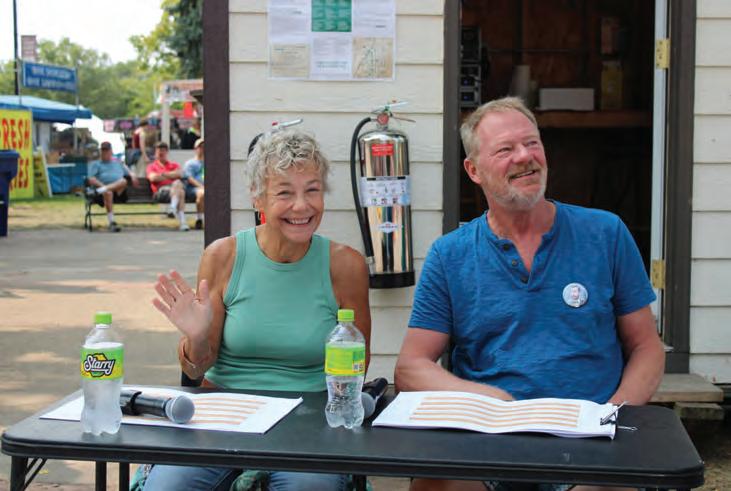
President. Sure, he’s talked with senators and governors, representatives and mayors, but never the person occupying the Oval. As a cycling buff, Johnson said he was thrilled to interview Travis Pastrana, a daredevil rider who recreated three of Evel Knievel’s dangerous stunts.
“ The best part of the job is talking to people,” said Johnson, on a particularly busy Tuesday in August after his morning shift ended. “It all happens in a two hour span. There’s so much going on.”
What also happens in front of the big Division Street windows is the occasional highjinx. Johnson remembers he was alone in the studio when three women flashed him as they were walking down the street.
Maybe that happened during the DJJD Festival or perhaps during Winter Walk, but he’s not quite certain.
Over the years, being a visible and audible member of the community usually had more advantages than drawbacks, he said.
TOP: Two community leaders in the arts, Pauline Jennings and Michael Johnson from the Northfield Arts Guild talked on the air with Johnson during a mid-August interview. (Pamela Thompson/ southernminn. com)
LEFT: Jeff Johnson relaxes on his bike during a previous motorcycle trip to Mexico.
(Submitted photo)
Living in a small, but highly engaged community like Northfield, listeners consistently told him what they did or didn’t like about an interview, and more often than not, what he should have asked the person he was talking with. Johnson said he learned long ago to take those comments and suggestions in stride. “I just try to keep the conversation going,” he said. “I’m everybody’s mouthpiece.”
Johnson said he has honed his smooth, easy banter that listeners have come to expect after the years of talking into a microphone. Through the years, he’s done interviews both comfortably seated inside one of the station’s two soundproof studios, as well as outside on cold, windy football stadiums, baseball diamonds or soccer fields.
“I’ve pretty much done every job at the station,” he said.
Of the many lessons his mentor Wayne Eddy taught him Johnson said none was more valuable than getting involved with the community he lived and worked in. “Wayne made sure that I joined non-profits, charities and service groups,” he said. “Being involved was the best way, along with the interviews and the programs, to become the voice of Northfield.”
Johnson said he has honed his familiar, steady and seamless delivery after one of the best radio jocks in the business, his mentor at KYMN Wayne Eddy. In 1968, Wayne and Stan Stynicki founded KYMN Radio and together operated the station until 1989 when Don


McRae became Eddy’s business partner. For 34 years, Eddy was KYMN’s sign on morning man. Johnson stepped up to the microphone when Eddy stepped down.
Johnson said saying goodbye to the legendary broadcaster, friend and mentor who died after an extended illness on Aug. 17 was difficult. Johnson was an honorary pallbearer at Eddy’s funeral at St. John’s Lutheran Church.
A final mic drop
Once he retires, Johnson said he will look forward not back.
“I stopped wearing a watch 10 years ago. I want to relax, not hurry and travel slowly,” he said. “If I like it somewhere, I’ll stay awhile.”
Johnson said he will look forward to having his life partner Terri Night by his side as copilot once she retires.
“It’s time to turn the page,” said Johnson. “But, I’m going to miss talking with so many different people.” n
Pamela Thompson is the associate editor for the Northfield News. Reach her at 507-645-1115 or pamela.thompson@ apgsomn.com.

Johnson’s office is decorated with old radio station signs, photos and broadcast trinkets collected over the years. (Pamela Thompson/southernminn.com) It’s time to turn the page. But, I’m going to miss talking with so many different people.”
Rich Larson, left, will take over KYMN Radio ownership on October 1st, while Logan Wells, right, will become the station’s news director. (Pamela Thompson/southernminn.com)
- Michael Johnson


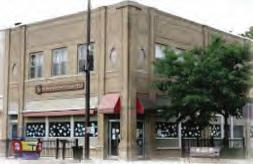

Mon. - Fri. 9am - 5:30pm; Sat. 9am - 5pm



Bring an egg bake or lasagna; mow their lawn; throw them a fundraiser; just do it. Because there’s always someone in a worse situation than you. We have a lot of signs that say ‘hope’ around our house — and there is always hope.”
- Ann Volk
is a ‘dynamo’ full of fun and service
By JANE MOORE Guest Contributor
Ann Volk has been giving St. Peter all her energy for many years. (Courtesy photo)
Empathy. Non-stop work. Positivity. Hometown loyalty. But above all, fun. Prepare to hear plenty about all of the above when dishing with Ann Wenner Volk.
The fifth-generation St. Peter resident pours her heart, soul and seemingly endless reserve of energy and verve into her family, job and community service endeavors.
And at the core of everything she does are two firm convictions: doing unto others as you

would have them do unto you is what makes life meaningful, and even in the dark valleys, there is always hope.
“Stamina runs in my family,” said Volk, the youngest of six children born to Margaret and the late Merton Wenner.
“My grandma was a ball of energy who lived to 91. And my 92-year-old mom is a two-time cancer survivor known around town as ‘The Cancer Lady,’ and let me tell you, she’s pretty impressive. And dad taught us that ‘gol darn’ good work ethic,” said Volk, no stranger to bean walking and farm chores.
Listening to Volk, it’s easy to assume that “git ‘er done spirit” and positivity might stem from a life free of hardship and brimming with
blessings.
But while Volk fully embraces an attitude of gratitude, she’s seen more than her share of trials.
“We know firsthand what it’s like to have hellish times and keep battling on,” she attested. “So we try to be there for other people going through their darkest moments.”
Volk is a 1985 St. Peter High School graduate who studied elementary education at Minnesota State University, Mankato. She’s a 27-year employee of Gustavus Adolphus College.
Currently administrative coordinator in the admissions office, she also has ongoing coordinating responsibilities for the institution’s signature events—Christmas in Christ Chapel, the Nobel Conference and annual commencements.
“It’s just so fun,” said Volk in her dependably effervescent manner. “They’re paying me and I’m having a blast. When the King and Queen of Sweden visited, I was two feet away from them.
“I mean, it was a lot of work but…it’s just so fun.”
Philly Kauffmann, Volk’s friend and a fellow longtime Gustavus staffer, readily vouches for Volk’s efforts and enthusiasm, both in the
“My grandma was a ball of energy who lived to 91. And my 92-year-old mom is a twotime cancer survivor known around town as ‘The Cancer Lady,’ and let me tell you, she’s pretty impressive. And dad taught us that ‘gol darn’ good work ethic.”
- Ann Volk
workplace and numerous volunteer pursuits.
“Ann’s a dynamo who always goes above and beyond,” said Kauffmann. “It’s kind of incredible to me.”
Kauffmann notes Volk’s supervision of the Gustavus Ambassadors and support of international students as two areas where Volk shines on the job.
“Ann has probably worked in every aspect of the campus at one point or another—advancement, marketing and admissions,” credited Kauffmann.
But it’s the lengthy list of Volk’s community contributions that prompts awe.
“If you’re a friend of Ann’s, you’ll get pulled into something,” joked Kauffmann, who has assisted Volk with several projects over the years.
Consider: Volk has coordinated the American Cancer Society’s Nicollet County Relay for Life for 30 years, spearheading fund receipts of over $1 million for cancer research to date; founded the Relay for Life at Gustavus a decade ago; been executive secretary of the Nicollet County Fair Board since 2009 (and previously volunteered with the fair), and is now in her third year as secretary of the District 2 Chapter of the Minnesota Federation of County Fairs; and in the past was a 12-year coordinator for the annual fundraiser at the Catholic Church
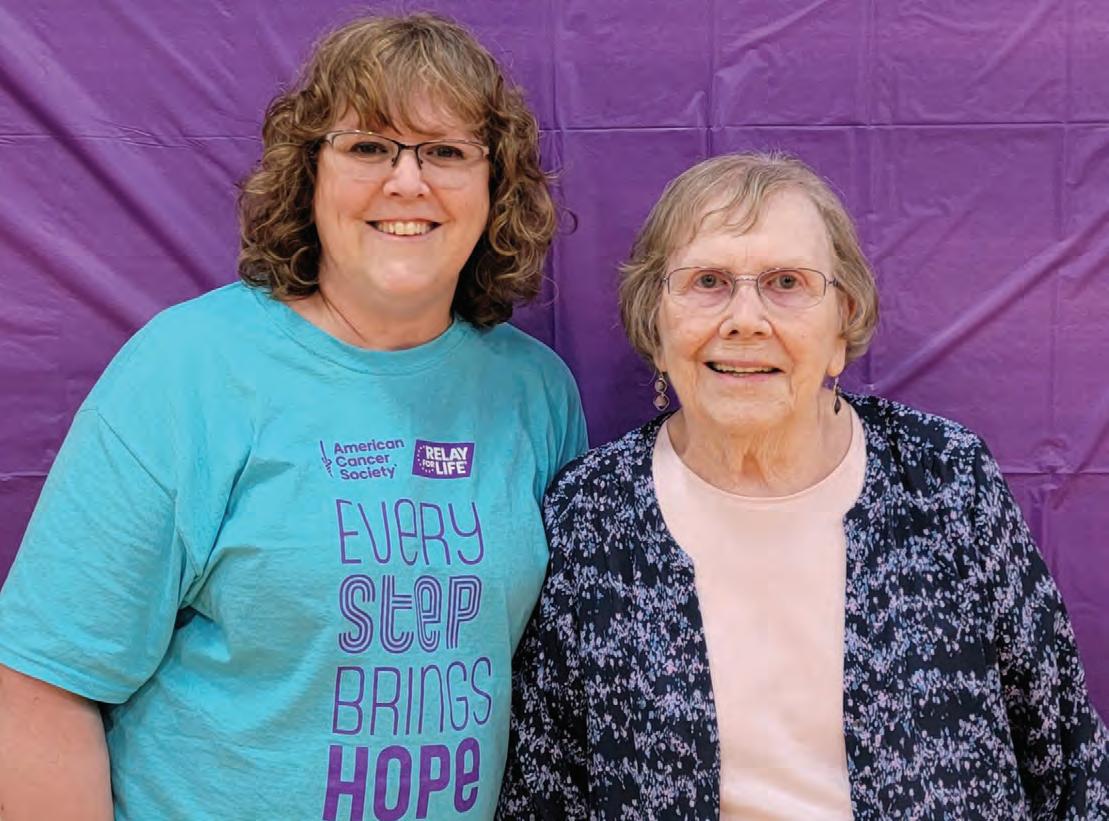
of St. Peter (and a religious education instructor there), a Girl Scout volunteer and, while her three daughters were in school, a stalwart volunteer for the girls’ tennis and track booster clubs, plus the “post-prom party planner” and an assistant with all-night graduation parties.
Additionally, she produces a monthly newsletter to maintain connections among the 400+ members of the extended Wenner family, most of whom live in the greater St. Peter area, and a bulk of whom are connected with agriculture. Oh, and she’s coordinated at least 25 fundrais-
CONTINUED ON PAGE 36
Ann Volk, second from left, in 2019, when she was diagnosed with breast cancer. She was supported by her family, including daughter Taylor Ann, husband Jeff, daughter Bailey, and daughter Jordan.




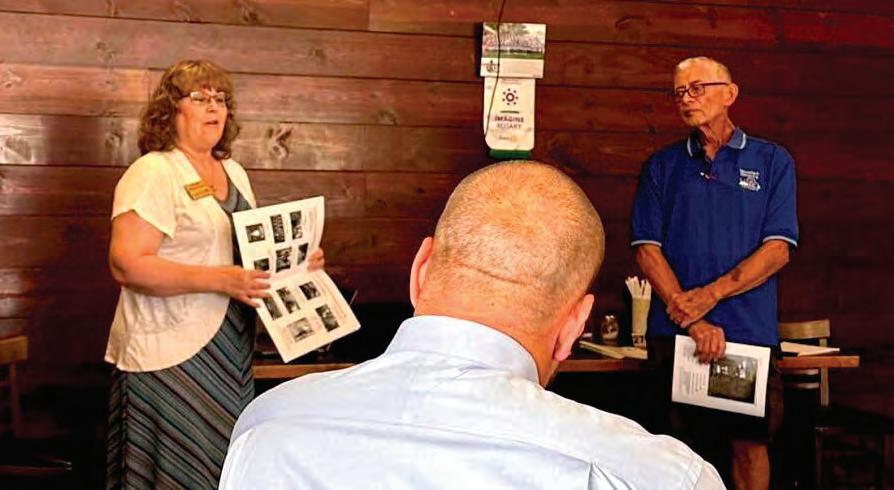
CONTINUED FROM PAGE 35
ing events for local individuals battling cancer, ALS or other debilitating illnesses. Whew. And the woman isn’t even a coffee drinker.
“I don’t have a clue how I did that,” laughed Volk, 55, reflecting on when her girls were younger. “I look back and think, ‘Oh my God, how did I do that?’ There’s no way I could do that now.”
But like the little engine that could, Volk keeps chugging.
A self-professed super organizer, Volk freely admits, “I couldn’t do it without a helpful spouse and daughters, a full Google calendar and lots of event checklists.”
Husband Jeff is a 24-year employee of Cambria, while daughters Jordan, Taylor and
Bailey—all graduates of St. Peter High School and, subsequently, of Gustavus—are central to everything in Volk’s life.
Her daughters—a sheriff’s deputy, medical professional and teacher, respectively—and their families, including four young grandchildren, all live nearby.
“It about killed me when they moved even 20 minutes away; I don’t know how people can live with their kids across the country,” said the family-centric Volk.
Yet Volk is no stranger to adversity.
At age 22, she became the primary caregiver to her mother and a sister who were diagnosed with cancer within two weeks of each other. Her older brother Steven died of ALS in 2020; her mother battled a second form of cancer in 2004; her father-in-law died of lung cancer in 2006; her youngest daughter was born with a cleft palate and endured seven surgeries as a child; her oldest granddaughter, Finnley, has Down syndrome; and two weeks before she coordinated the 25th local Relay for Life event, Volk learned she herself had breast cancer.
Yet mere days after a mastectomy that involved removal of several lymph nodes, Volk was at the county fair, even logging a 14-hour day less than a week post-surgery.
“When you’re busy setting up a fair, you don’t notice the pain,” she smiled. “And it was better than staying at home, catastrophizing.”
With her own cancer in remission, Volk has slowed down — ever so slightly — to maintain good health.
But prioritizing others is always at the forefront of her life and schedule.
“When you’ve had that many relatives with cancer, ALS and Down syndrome, you learn to be very empathetic,” she said.
“Bring an egg bake or lasagna; mow their lawn; throw them a fundraiser; just do it,” Volk exhorted. “Because there’s always someone in a worse situation than you.
“We have a lot of signs that say ‘hope’ around our house — and there is always hope.” n
Jane Turpin Moore is a freelance writer. Contact the editor at editor@apgsomn.com.





By JANE MOORE Guest Contributor
Tall as a real tree, Kiesler’s Campground and RV Resort’s welcoming mascot KC is a lively embodiment of the values its owners aim for in every aspect of their 52-year-old business: friendliness, positive energy, vibrancy, flexibility, fun and smiles for all.
“KC is a tree the kids go crazy for,” said Kristi Corchran, 39, who, along with her husband Mike, 43, and parents, Steve and Belinda Kiesler, operates the popular resort situated on the southeast shores of Clear Lake in Waseca.
“My dad helped design our logo years ago, with a smiling tree in it, and that became the
inspiration for KC,” she said. Guests lucky enough to reserve time at one of Kiesler’s 350 campsites (260 spots are available as seasonal rentals; there’s a two- to threeyear waiting list for those, and reservations for other availability are accepted up to a year in advance) rave about the Kiesler’s Campground experience.
It includes access to a 2,000-square-foot heated pool, kiddie pool, shuffle board and volleyball courts, arcade, recreation hall for those inevitable inclement days, remote control car track, horseshoe pit, mini-golf, two playgrounds, KC’s Snack Shack and a camp store offering souvenirs and camping necessities. Oh, and don’t forget the option of pontoon and fishing boat rentals, plus a nearly endless supply of thematic activities for kids and families alike.
“ There’s always something to do at Kiesler’s,” said Diane Ambroz, 70. Ambroz and her husband Todd have made Kiesler’s their home away from (their relatively nearby Faribault) home for the past 16 years.
“ The Kiesler’s crew really cares about the people who are camping here, and there are activities every hour that involve parents with children. It’s wonderful to make memories with mom and dad, or grandma and grandpa, and Kristi and Mike are parents themselves so they know what kids want.”
Kristi confirms that from Memorial Day through Labor Day (the campground opens in late April and closes in early October), Kiesler’s plans a full complement of activities, centered around “theme weekends,” from 9 a.m. to 9 or 10 p.m. daily.
“People have compared our activities to
cruise ship schedules,” laughed Kristi. “We have things for various age groups—6 and under, 18 and up and every age in between. And we do crazy, messy relays [with substances like shaving cream and mud], ‘minute-to-win-it’ games, dances with DJs, bingo—it’s jam-packed.”
That’s due, in part, to the Corchrans and Kieslers viewing everything from a family lens, considering what they would enjoy and appreciate were it their own vacation rather than another day of work — albeit joyful, intergenerational work.
“As a mom, I know a vacation doesn’t feel like a vacation for me if I have to spend all my time planning things to keep the kids busy,” said Kristi. She and Mike are parents to sons Jaxon, 9, and Jameson,11.
“We try to take that off the parents so they

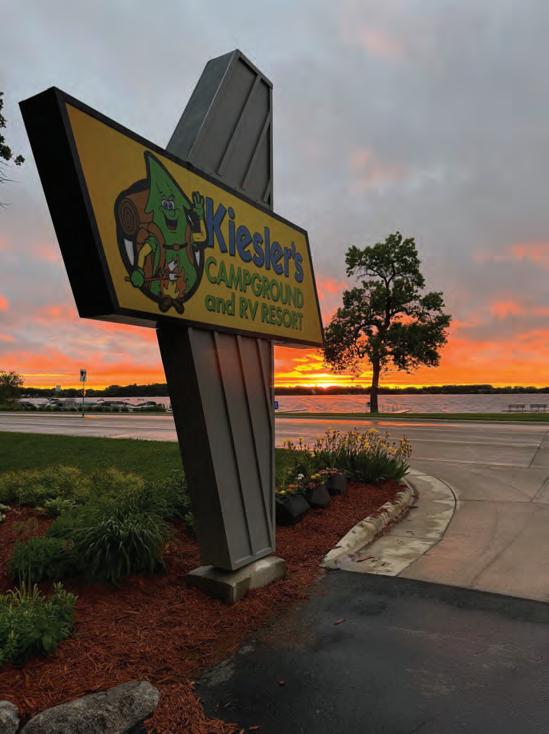

CONTINUED FROM PAGE 37
can relax a little bit too—and we have an awesome, awesome staff that truly cares about the guest experience,” she continued.
“We employee between 40 and 45 people every summer and they’re all outstanding people who care about our guests as much as we do.
a young child, helping with tasks around the place and loving it from the start,” said Kristi.
According to Kristi, her grandparents, Barb and Kal Kiesler, began in the early 1970s converting the acreage that is today’s campground from the strawberry patch it once was. Kal Kiesler, reputedly a hard-working man of German descent, believed developing a campground would enable his four children to learn a solid work ethic and many useful trade skills.
“My grandparents wanted their own family to work and be together, and they poured what they did into creating a place for other families to relax, create memories and enjoy time together,” said Kristi. “There aren’t a lot of businesses you can say are all about creating joy for people.”
Kal and Barb’s son Steve became a master electrician but remembers well the hands-on effort it took to establish Kiesler’s Campground.
“Dad had three jobs sometimes to keep things rolling,” said Steve.
When Steve was 18, his parents encouraged him to leave Waseca for a time.
“ They wanted to make sure we experienced other things and other jobs,” said Steve.
He and Belinda lived in Texas, where both Kristi and her sister Katie were born. When Kristi was about seven, the family returned to Waseca. Steve, Belinda and their girls jumped in to campground life at full throttle.
“I loved talking to all the customers, and I got to meet new kids every weekend so it was a really fun environment,” said Kristi, who estimates she worked 40 hours a week each summer from age 12 on.
One of our 16-year-old employees said in late August, ‘I just love it; they know my name and I know theirs.’ It’s a cool relationship, and we try to make our guests feel like family every time they’re here.”
Kristi and Mike emphasize customer service, guest satisfaction and cleanliness.
“We’re known in the industry for the cleanli-
ness of our facility and for our high level of customer service,” said Kristi.
“Our rangers guide every single party to their campsite, so every guest gets personal attention from the moment they arrive.”
Employee empowerment is one key to Kiesler’s Campground’s success.
“For a lot of our employees, this is their first job. We strive to make a good impression on them and communicate that details are important,” said Mike.
“Many former employees return years later with their own families, or stop by to tell us what a great first job it was for them and how we helped instill a good work ethic.”
Added Steve Kiesler, “We’re all approachable, and we train the staff to know that if a guest has a problem or asks for something, they can figure it out or deliver it—unless it’s something huge.
“We really empower them to make decisions and let them help the customer on the spot.”
That method has certainly registered with Ambroz and her family.
“ They go above and beyond with what they do,” said Ambroz, who’s loved how kids are readily awarded prizes for games in which they participate or given coupons for freebies at KC’s Snack Shack or the camp store.
“ They’re [all the employees] so friendly, and the campground is so clean. It’s a safe, secure, fun place to be. And from April to October, the seasonal campers are a family along with them.”
As longtime Kiesler’s campers, Ambroz and her husband sometimes assist with certain activities, like wagon rides and a kids’ carnival in July.
“We mourn the end of the season at the campground,” she said.
Is it merely a coincidence that Kristi’s initials — KC — are the same as those for Kiesler’s Campground?
Perhaps, but Kristi has been steeped in the Kiesler’s culture her entire life.
“I remember coming to the campground as
When Kristi came of age, she earned a bachelor of fine arts degree, with an emphasis on interior design, at University of Wisconsin, Stout, before moving to Colorado to work in that field for a few years.
“My parents told me the same thing — that I had to move away and do something else because they didn’t want me to have any regrets about not having tried something new,” she said.
Yet the campground proved a magnet for Kristi, who called her dad every so often to ask, “Can I come back yet?” He eventually agreed she’d spread her wings long enough, and Kristi moved home.
Meanwhile, Mike Corchran remembered the slightly younger Kristi as “one of my little brother’s friends I’d see around occasionally,” he said. “She was in eighth grade when I was a senior in high school, so we didn’t even have a conversation at that stage.”
During Kristi’s self-imposed exile in Denver, though, the two connected through mutual friends, and their relationship developed quickly thereafter.
“We started dating when she moved back to Waseca, became engaged about nine to 10 months later and married 10 months after that,” said Mike.
Their first son, Jameson, arrived just less than a year after their wedding, and their second son, Jaxon, was born less than two years after his elder brother.
“It was a busy stretch for us,” Mike understated.
Meanwhile, Kristi had taken a deep dive into Kiesler’s Campground; she’s put her academic background and technical skills to use in many ways.
“I use all the graphic design knowledge I gained and I do our website design, created our phone app and designed the interior of our Snack Shack,” Kristi listed.
She also produces Kiesler’s Campground brochures and digital ads.
“It takes a lot of time, but I love design,” said Kristi. “It might be easier to hire it out, but I’m too particular.”
While Kristi represents the third generation of Kieslers to run the campground, Mike was similarly the third generation of his family to operate a different Waseca business—the former Lakeshore Inn, now known as Lakeshore Rehabilitation Center.
“My grandparents owned the nursing home here, and I had every intention of staying there because I really was helping people,” said Mike. But as their dating relationship grew more serious, Kristi and Mike realized that if each stuck with their family legacy business, they’d have many scheduling conflicts.
“And we knew we wanted to have kids so we thought about where they might prefer to grow up — at a nursing home or a campground?” Mike said. “The answer seemed obvious.”
Mike, a University of St. Thomas graduate, continued managing Lakeshore Inn for several years, helping at Kiesler’s Campground on weekends. A challenge for Mike was the fact that, unlike his father-in-law Steve, he was not naturally mechanically inclined nor trained— and at a campground, repairs are a constant reality.
“You have to be a jack of all trades here,” said Steve.
Said Mike, “I joke that Kristi’s family could fix anything and my family wrote a check to have someone else do it. But I got thrown in the deep end and I’ve learned a ton.
“It’s been nice to learn from Steve, and we have ‘work campers’ who help us every summer; one was a former plumber, for instance, and I’m now a certified pool operator.”
After Mike’s family sold Lakeshore Inn, he, too, was all-in at Kiesler’s Campground. While his energies are focused on the outdoors—pool, lawn and equipment maintenance—Kristi is

geared to the inside work, including marketing and programming.
In or out, running a campground is an enormous endeavor and requires an “all hands on deck” mentality.
“We put in a couple thousand hours of work—what most people do in a year—in about six months,” said Steve. “It’s not for everybody.”
Notably, the Corchrans and Kieslers engage in and promote the greater Waseca community. Their guests spend time and money shopping, dining and even making major purchases (like vehicles from Deml Ford).
“Waseca has amazing restaurants, boutiques


and antique shops,” said Kristi. “It’s really awesome to see so many businesses thriving here.”
Mike listed a number of local businesses that benefit from the thousands of guests their campground hosts each year, naming hardware and appliance stores, RV suppliers and restaurants.
“ There’s a trickle-down effect, for sure,” he said.
Additionally, Mike is a past president of the Waseca Hockey Association and has coached every level of hockey, from learn-to-skate up to varsity, over the past 20 years.
“My dad passed away when I was young and I looked up to some of my coaches as father figures,” said Mike. “I see coaching as a way for me to give back and help other kids have that
same kind of experience.”
Mike has also served on various community boards in past years, and he hopes to do so again when their sons are grown. At all times, the Corchrans and Kieslers are proud to be residents and contributors to the greater Waseca community.
“Our town is fantastic,” enthused Steve. And operating Kiesler’s Campground as a committed team only adds to their satisfaction.
“We’re so family-focused; we get to engage with people, smile, laugh and help create memories they’ll have forever,” said Kristi. “This job is so rewarding.” n Jane Turpin Moore is a freelance writer. Contact the editor at editor@apgsomn.com.






